List of apple cultivars


Over 7,500 cultivars of the culinary or eating apple (Malus domestica) are known.[1] Some are extremely important economically as commercial products, though the vast majority are not suitable for mass production. In the following list, use for "eating" means that the fruit is consumed raw, rather than cooked. Cultivars used primarily for making cider are indicated. Those varieties marked agm have gained the Royal Horticultural Society's Award of Garden Merit.[2][3]
This list does not include the species and varieties of apples collectively known as crab apples, which are grown primarily for ornamental purposes, though they may be used to make jelly or compote. These are described under Malus.
Table of apples
[edit]Abbreviations
[edit]| Abbreviations | Full form | Abbreviations | Full form |
|---|---|---|---|
| AC | Apple canker | AM | Award of Merit |
| AS | Apple scab | AGM | RHS Award of Garden Merit |
| C, VitC | Vitamin C mg/100g | BB | Biennial bearing |
| FCC | First Class Certificat | DBH | Days from full bloom to harvest |
| PW | Powdery mildew | P | Parentage |
| RHS | Royal Horticultural Society | r | Resistant |
| PickG[4] Pickg[5] | Harvest time in Germany | Pick45 | Harvest time at places with a mean annual temperature of 45 °F (7 °C) |
| PickE[6] Picke[7] | Harvest time in south England | Pick50 | Harvest time at places with a mean annual temperature of 50 °F (10 °C) |
| s | Susceptible | Pick55 | Harvest time at places with a mean annual temperature of 55 °F (13 °C) |
| TA | Titratable acidity % | SS | Soluble solids % |
| TRI | Triploid | ||
| Languages | |||
| cs. | Czech (Čeština) | da. | Danish (Dansk) |
| de. | German (Deutsch) | fr. | French (Français) |
| hu. | Hungarian (Magyar) | nl. | Dutch (Nederland) |
| no. | Norwegian (Norsk) | pl. | Polish (Polski) |
| ru. | Russian (Русский; Russky) | sv. | Swedish (Svenska) |
A
[edit]| Common name | Image | Origin | First developed | Comment | Use | Pick/Use period |
|---|---|---|---|---|---|---|
| Abbomdanza[8][6] |  | Italy | 1896 | Width 70–75 mm, height 65 mm. Cold Storage 3oC 150 days. | Cooking | PickE mid-October. Use January–March |
| Abram[9][10] |  | US | <1850 | A small apple with red flush. Flesh white, tender, subacid. | Eating | Use December–March |
| Acheson[11] | Alberta, Canada | Introduced 1941 | Fruit large, greenish yellow. Parentage Delicious x unknown. | Eating | Use August–September | |
| Acklam Russet[12][13] |  | Yorkshire, England | 1768 | A small russet apple. Cells ovate, axile. An excellent dessert apple of first rate quality. | Eating | PickE mid-October. Use November–March. |
| Adams Pearmain[14][7][9][15][13] |  | Norfolk or Herefordshire, England | Introduced 1826 | A dessert apple. First introduced under the name "Norfolk Pippin". Width 64 mm (2.5 in), height 63 mm (2.5 in). Cells obovate, abaxile. Flesh pale yellow, crisp, fine-textured, firm, juicy, subacid, aromatic, very good. | Eating | PickE early- to mid-October. |
| Adersleber Calville (cs. Kalvil aderslebenský)[16][4][17][8] |  | Saxony, Germany | 1830–1840 | A green apple with red flush. Width 72 mm (2.8 in), height 58 mm (2.3 in). Stalk 16 mm (0.63 in). Parentage Calville blanc d'Hiver x Alexander. Flesh; aromatic, subacid to sweet. VitC 10. Cold Storage 0oC 150 days. | Eating | PickE mid-September. PickG mid–late October. Use November–January. |
| Adina (a.k.a. Frankad, Satark)[18] | Queensland, Australia | 1950s, introduced in 1988 | A large red apple. Flesh firm, juicy, sweet, very good. Tree vigorous. Parentage Golden Delicious x William's Favourite | Eating | ||
| Admiral |  | Czech Republic | 2012 | New very popular variety. Flesh firm, crisp, juicy with very good taste. Robust, healthy, scab resistant variety with excellent keeping qualities and taste. | Eating | PickE early October |
| Advance (a.k.a. Laxton Advance)[7] |  | Bedford, England | Raised 1908, introduced 1929 | Early dessert apple. Medium size. Yellow with brown-red flush. Award of Merit from RHS in 1932. Flesh; greenish white, soft, fine-textured, juicy, aromatic. | Eating | PickE early- to mid-August; use August–September |
| Adzamovka[19] | Croatia | A yellow conical apple with red stripes. Width 60–70 mm (2.4–2.8 in), height 50–60 mm (2.0–2.4 in), weight 110–150 g (3.9–5.3 oz). Flesh juicy, subacid. | Eating, cider | Use November | ||
| Ahrina[20] |  | Germany | 1993 | A large roundish apple. Flesh juicy, subacid. | Eating | Pick late September; use November–February |
| Ahrista[21] | Ahrensburg, Germany | Eating | ||||
| Aia Ilu | Estonia | 1946 | A large apple, weighing 250–300 g (8.8–10.6 oz). Yellow skin, juicy flesh, bittersweet with a weak aroma. | Eating | ||
| Airlie Red Flesh (a.k.a. Newell-Kimzey)[22] | Airlie, Oregon, US | c. 1961 | A large, conic apple. Light yellow-green skin strewn with white dots, occasionally with a faint reddish orange blush. Light pink to deep red flesh is crisp, sweet and mildly tart. | Eating | ||
| Akane (a.k.a. Tohoko)[23][4] |  | Fujisaki, Aomori, Japan | Cross made 1939, selected 1953, introduced 1970. | A red apple. Parentage Jonathan × Worcester Pearmain. Tangy taste. Flesh is white, firm, crisp, juicy, subacid. | Eating | Pick45 August 21. PickE mid- to late-August. PickG mid-August. |
| Åkerö[24][25] | 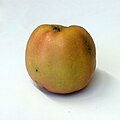 | Sweden | Possibly 1759 | Apple is egg-shaped, medium to large in size, sweet and aromatic. Width 68 mm (2.7 in), height 68 mm (2.7 in). Stalk 20–25 mm (0.79–0.98 in). Grown mostly in Sweden and Estonia. | Eating | Best in November; keeps until February |
| Akin[26][27] |  | Illinois, US | 1831 | Tree vigorous. Width 68 mm (2.7 in), height 52 mm (2.0 in). Stalk 20 mm (0.79 in). Flesh is yellow, crisp, tender, juicy, subacid, aromatic, good to very good. | Eating | Use January–June |
| Alamanka[19] | North Macedonia | A green apple (round to conical) with red stripes. Weight 100 g (3.5 oz). Flesh is juicy, subacid with poor aroma. | Eating | Pick October; use November | ||
| Alantapfel (a.k.a. Princesse Noble)[24][15][28] |  | Germany | <1750 | An oblong apple. Width 56–63 mm (2.2–2.5 in), height 59–73 mm (2.3–2.9 in). Stalk 13–16 mm (0.51–0.63 in). Flesh is sugary, aromatic. | Eating | Pick October; use December–March |
| Alaska[11] | California, US | Introduced 1944 | Flesh is white. Tree is a heavy producer. | Eating | ||
| Albrechtapfel (a.k.a. Prinz Albrecht von Preussen)[20][4][8] |  | Germany | 1865 | Parentage Alexander x unknown. Width 60–85 mm (2.4–3.3 in), height 55–63 mm (2.2–2.5 in), weight 80–200 g (2.8–7.1 oz). Stalk 10–30 mm (0.39–1.18 in). Flesh is soft, juicy, subacid. Cold Storage 4oC 90 days. VitC 9. Density 0.76 | Eating, cooking | PickG late September–mid-October. Use October–December |
| Albury Park Nonsuch[14] | Surrey, England | <1892 | Yellow with red flush. AM from RHS in 1892. Flesh crisp, juicy, subacid. | Cooking | Use December–March | |
| Aldenham Purple[29] |  | Hertfordshire, England | 1925 | A red apple. Width 63 mm (2.5 in), height 48 mm (1.9 in). Stalk 15–25 mm (0.59–0.98 in) | Eating, cooking | Pick September; use September–October |
| Alderman[7][30] |  | Scotland | Before 1923 | A golden yellow apple. Width 90 mm (3.5 in), height 71 mm (2.8 in). Stalk short to medium. Flesh is white, very firm, coarse-textured, crisp, moderately juicy, acid. | Baking | Pick mid-September; use October–December |
| Alexander (a.k.a. Emperor Alexander, de. Kaiser Alexander, fr. Grand-Alexandre, pl. Aporta, ru. Aporta, Gusevkoe, Aport ukraininskii, Aport osennii)[7][24][31][26][27][32][33][34][13][17] | 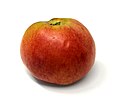 | Russia | <1800 | A very large apple. Width 95–110 mm (3.7–4.3 in), height 75–90 mm (3.0–3.5 in). Stalk 11–18 mm (0.43–0.71 in). Cells ovate, axile. Flesh is a faint yellow, firm, crisp, very soft, mild subacid, fair to good. Tree is vigorous. Particularly attractive blossom. | Eating, cooking, baking, drying | PickE mid-September; use September–December |
| Alfriston[14][7][30][35][13][28] |  | Sussex, England | Late 1700s | Raised at Uckfield Sussex by Mr Shepherd.[who?] A large acid green apple. Flesh; pale yellow, crisp, yellow, subacid, pear-like flavour. Cells elliptical, abaxile. Award of Merit from RHS in 1920. Width 83 mm (3.3 in), height 76 mm (3.0 in). | Cooking, Juice | PickE early October; use November–April |
| Alice[25] | 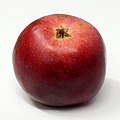 | Sweden | 1964 | Medium size. Yellow with red stripes. Flesh juicy, aromatic. Parentage Ingrid Marie x Gyllenkroks Astrakan. | Eating | PickE late August–early September; use September–October |
| Alkmene[4] agm[36][8] |  | Germany | 1930 | Parentage Cox's Orange Pippin × Doktor Oldenburg. Width 58 mm (2.3 in), height 58 mm (2.3 in), weight 120 g (4.2 oz). Flesh is crisp, aromatic, juicy, subacid to sweet. Stalk 9–20 mm (0.35–0.79 in). Cold Stoprage 4oC 90 days. Density 0.82 | Eating | PickE late September. PickG early–mid-September. Pickg September 4–15. Use September–November |
| Allen's Everlasting[7][30][13][28] |  | Before 1864 | Late-keeping desert apple. First Class Certificate from RHS in 1899. Cells obovate, axile. Flesh is greenish-white, firm, fine-textured, juicy, fair. | Eating | PickE mid-October; use February–April | |
| Allington Pippin(fr. Allington Pippin)[7][24][31][30][16][35][17][8] |  | Lincolnshire, United Kingdom | 1880s, introduced 1896 | A versatile English dessert apple raised by horticulturalist Thomas Laxton some time before 1884. Exhibited as Brown's South Lincoln Beauty, the name was changed to Allington Pippin by Bunyard Nursery in 1896. A cross of Cox's Orange Pippin and King of the Pippins. Flesh is creamy white, fine textured, aromatic, with a pineapple-like flavour. The apple keeps its shape when cooked. Width 68–74 mm (2.7–2.9 in), height 61–70 mm (2.4–2.8 in), stalk 7–15 mm (0.28–0.59 in). First Class Certificate from RHS in 1894. Cold storage 2oC 120 days. | Eating, cooking, dessert | PickE late September–early October; use October–February |
| All Summer[9] |  | Pennsylvania, US | Before 1850 | Flesh is white, tender, very good. Tree uas slow growth is an annual bearer, and is productive. Stalk slender. | Eating | Use July–August |
| Almeda[11] | Tennessee, US | Introduced 1939 | Fruit large, green. Flesh subacid. | Cooking | Ripens 25 July–5 August | |
| Altländer Pfannkuchenapfel[4][8] |  | Germany | 1840 | Width 67 mm (2.6 in), height 51 mm (2.0 in), weight 115 g (4.1 oz). Stalk 10–20 mm (0.39–0.79 in). Flesh is crisp, dry, acid. Cold storage 1-2oC 180 days. VitC 14. Density 0.86 | Cooking, eating | PickE mid- to late October. Pick G late October. Use March–May |
| Alvanija (a.k.a. Elvanija, Ilvanija)[19] | Croatia | A green oblong apple with red flush. Width 60–75 mm (2.4–3.0 in), height 65–80 mm (2.6–3.1 in), weight 110–140 g (3.9–4.9 oz). Flesh is firm, juicy. | Eating, cooking, cider | Use October | ||
| Ambrosia |  | British Columbia, Canada | 1980s | Medium to large in size, mostly red coloration with yellow patches. Has cream-coloured flesh with a sweet, crisp, aromatic flavour and low acidity. Ambrosia trees are hardy and no major disadvantages have yet been identified. | Eating | Pick45 September 15. Pick55 September 5. |
| American Beauty[9] |  | Massachusetts, US | Before 1855 | Tree vigorous, productive, annual bearer. Stalk short. Flesh is yellowish, tender, juicy, subacid, aromatic, very good. | Eating | PickE mid- to late October. Use December–April |
| American Golden Pippin (a.k.a. Golden Pippin, Ribbed Pippin, Golding, New York Greening, Newtown Greening, Golden Apple)[9] |  | US | Before 1850 | Yellow with russet. Flesh is yellowish, juicy, aromatic, subacid, very good. Width 79 mm (3.1 in), height 65 mm (2.6 in). Stalk 16 mm (0.63 in). Tree does not bear young. | Eating | Use November–February |
| American Golden Russet (a.k.a. Golden Russet, Sheep Nose, Bullock's Pippin, Little Pearmain)[12][27] |  | US | Late 1700s | Yellow with brown overcolour and grey russet. Width 64–74 mm (2.5–2.9 in), height 58–72 mm (2.3–2.8 in). Stalk 13–23 mm (0.51–0.91 in). Flesh is yellowish, tender, juicy sugary, lightly aromatic, best. | Eating | PickE early to mid-October. Use October–January |
| American Melon (see Melon American) | ||||||
| American Mother (see Mother) | ||||||
| American Summer Pearmain (see Summer Pearmain American) | ||||||
| Anabela[18] | Brazil | Introduced 1995 | Parentage Gala x Anna. A yellow apple with (30–40%) red flush. Flesh is juicy, sweet, very good. Tree vigorous. | Eating | ||
| Ananas Reinette(cs. Ananasová reneta, de. Ananas Renette, fr. Reinette ananas, pl. Reneta Ananasowa, ru. Ananasnîi renet)[4][24][37][15][16][35][17] |  | Netherlands | Before 1800 | A small yellow apple with pineapple flavor. Width 48–65 mm (1.9–2.6 in), height 52–65 mm (2.0–2.6 in). Weight 115 g (4.1 oz). Stalk 11–20 mm (0.43–0.79 in). Flesh is crisp, juicy, aromatic, acid. VitC 21. | Eating, juice | PickE early October. PickG mid- to late October. Use December–February |
| Anisovka (a.k.a. Anis koritschnevoje, Anis polosatyiy)[38] | Russia | Before 1850 | Medium size, round, greenish yellow with red stripes. | Cooking, eating | Pick September; use October–December | |
| Anna[18] | 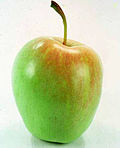 | Israel | Introduced 1963 | Colour is yellow with a red blush. Parentage Red Hadassiya x Golden Delicious. This variety does not grow well in the cold and prefers heat and humidity. Tree is annually productive. | Eating | |
| Anna Boelens[39] | Netherlands | 1914, introduced 1934 | A green apple with red overcolor(40-70%). Width 77 mm, height 58 mm. Stalk 15 mm. Flesh white, juicy, subacid. Parentage Cox Orange x Berlepsch. | Eating | Use October - November | |
| Annie Elizabeth[40][14][7][31][35][13][28] |  | Leicester, Leicestershire, England | 1857, introduced 1868 | Large yellow apple, FCC from RHS in 1868. Width 79–87 mm (3.1–3.4 in), height 63–65 mm (2.5–2.6 in). Stalk 9–18 mm (0.35–0.71 in). Cells, obovate, abaxile.Flesh; creamy white, firm, coarse-textured, dry acid. Cooks well, breaks up completely. | Cooking | PickE late September–early October; use November–April |
| Annurca |  | Campania, Italy | 1876 (documented) | Very old apple; possibly one of the oldest of all. Believed to be much older than first mention in Pasquale's Manuale di Arboricultura, 1876. May be related to apples found in frescoes found in Herculaneum or Pompeii if not the same one.[41] | Eating | PickE late October. Use November–January. |
| Antonovka (a.k.a. Possarts Nalivia, cs. Antonowka, de. Antonowka, fr. Antonovca, pl. Antónówka zwykla, ru. Antonoka Obîknovennaia)[24][32][28][17] |  | Kursk, Russia | Before 1800 | A very old Russian variety, often planted at dachas. Apples are large, yellow-green and bracingly tart to eat out of hand, but superb for cooking, as they keep their shape. Width 55–70 mm (2.2–2.8 in), height 55–70 mm (2.2–2.8 in). Stalk 10 mm (0.39 in). Extremely tolerant of cold weather, and because it produces a single, deep taproot (unusual among apple trees), Antonovka is propagated for use as a rootstock. Antonovka rootstock provides a cold-hardy (to −45 °C (−49 °F)), well-anchored, vigorous, standard-sized tree. C 15. | Cooking, cider | PickE early September. Use October–December |
| Antonovka Safrannoje[38] | Russia | 1909 | A large yellow apple with red flush. Parentage Antonovka x Renet Orleanski | Eating, cooking | ||
| Apfel aus Grignon[28] |  | Before 1800 | A yellow apple with red flush and russet. Width 82 mm (3.2 in), height 66 mm (2.6 in). Stalk 30 mm (1.2 in). | Eating, cooking | Use December–March | |
| Api[12][33][34] |  | France | 1628 | Very tiny apple. Would fit in the palm of the hand of an adult. Width 52–56 mm (2.0–2.2 in), height 32–42 mm (1.3–1.7 in). Stalk 5–9 mm (0.20–0.35 in). | Eating | PickE mid-October. Use January–May. |
| Api Noir[12] |  | France | Late 1700s | A desert apple, inferior to the Api. | Eating | PickE mid- to late October. Use December–April. |
| Apple of Commerce 1 (see Beach); Apple of Commerce 2 (see Collins) | ||||||
| Apollo[4] | Germany | 1976 | Cox's Orange Pippin × Geheimrat Dr. Oldenburg. Width 69 mm (2.7 in), height 59 mm (2.3 in), weight 140 g (4.9 oz). Stalk 13 mm (0.51 in). Flesh is soft, juicy, aromatic, subacid to sweet. | Eating | PickG early–mid-September; use September–October | |
| Arapka (a.k.a. Bugarka)[19] | Montenegro | A red oblong conical apple. Width 61 mm (2.4 in), height 66 mm (2.6 in). Weight 118 g (4.2 oz). Flesh soft, juicy, sweet, subacid, with a pronounced flavour. | Cooking | Use October–May | ||
| Ard Cairn Russet[7][6] | Cork, Ireland | c. 1890 | Medium-sized long-keeping dessert apple. Award of Merit from RHS in 1910. Width 69 mm (2.7 in), height 63 mm (2.5 in). Stalk variable. Flesh; creamy white, firm, slightly aromatic flavour. Tree vigorous. | Eating | PickE late September–early October; use October–January | |
| Ariane[42] |  | Angers, France | 2002 | Scab resistant. Developed at the National Institute of Agricultural Research in France. Parentage (Florina x Prima) x (Golden Delicious x unknown) | Eating | Pick with Golden Delicious |
| Arkansas Black (a.k.a. Arkansas, Mammoth Black Twig)[26][27] |  | Arkansas, US | c. 1870 | Hard and crunchy; stores well. Width 69 mm (2.7 in), height 60 mm (2.4 in). Stalk 20 mm (0.79 in). Very deep red, appearing black from a distance. Flesh is yellow, firm, tender, juicy, subacid, crisp, good. | Eating | Pick45 October 22. Pick55 October 15. PickE late October. Use December–May |
| Arlet[4][43][44] |  | Dietikon, Switzerland | Introduced 1984 | Width 72 mm, height 66 mm. Parentage Golden Delicious x Idared. 55-100% Red overcolor. Flesh is crisp, juicy, aromatic, subacid. | Eating | PickG early–mid-October. Use November–February. |
| Armorel[14] | Newbury, Berkshire, England | Introduced 1893 | A small yellow apple with russet. FCC from RHS in 1892. Flesh crisp, good. | Eating | Use February–May | |
| Aroma[25] |  | Balsgård, Fjälkestad, Sweden | 1947, Introduced 1973. | A yellow apple with red flush. Width 63 mm (2.5 in), height 58 mm (2.3 in). Parentage Ingrid Marie x Filippa. | Eating | PickE early October. Use November–December |
| Aromatic Russet(fr. Rouge Aromatisée)[9][34] |  | England | <1831 | Width 55 mm, height 50 mm. Flesh is greenish white, firm, subacid, aromatic. | Eating | PickE mid-October. Use November–February |
| Arreskov[24][35][28] | Denmark | Before 1860 | A yellow apple with a pleasant aroma reminiscent of gravenstein. Width 77–85 mm (3.0–3.3 in), height 66–75 mm (2.6–3.0 in). Stalk 8–15 mm (0.31–0.59 in). Flesh is firm, dry, aromatic, subacid. Tree vigorous. | Eating, juice, drying. | Pick September. Use September–October. | |
| Arthur Turner[7][14] agm[45][31][46] |  | Buckinghamshire, England | Before 1912, introduced 1914 | Width 80–88 mm (3.1–3.5 in), height 48–76 mm (1.9–3.0 in). Stalk 10–16 mm (0.39–0.63 in). Large golden cooker: prone to mildew but scab resistant. Award of Merit from RHS in 1912. Flesh is creamy white, coarse-textured, dry, subacid. Parentage Alfriston x unknown. | Cooking, baking | PickE late September; use September–November |
| Arthur W. Barnes[7] |  | Chester, England | Raised 1902, introduced 1928 | Parentage Gascoyne's Scarlet x Cox Orange. A yellow apple with red flush. Width 82 mm (3.2 in), height 70 mm (2.8 in). Stalk medium. Flesh is white, firm, fine textured, very juicy, acid. | Cooking | PickE mid- to late September; use November–March |
| Ashmead's Kernel[7][14]agm[47]<[31][13] |  | Gloucestershire, England | c. 1700 | Flesh is pale yellow, juicy, subacid and very aromatic. Width 54–64 mm (2.1–2.5 in), height 54–57 mm (2.1–2.2 in). Stalk 7–12 mm (0.28–0.47 in). Cells obovate, axile, slit. | Eating | PickE early–mid-October; use December–February |
| Ashmore[10][9] |  | US | Before 1840 | Width 85 mm (3.3 in), height 66 mm (2.6 in). Stalk 11 mm (0.43 in). Flesh is yellowish-white, crisp, juicy, subacid, very good. | Cooking, eating | Use September–October |
| Astillisch[6] |  | Germany | Raised 1929 | Parentage Red Astrachan x Signe Tillisch. Width 63–70 mm, height 56 mm. Flesh yellowish-white, juicy, soft, subacid. | Eating | Pick August. Use August. |
| Astramel[4] |  | Jork, Germany | Parentage Red Astrachan x (James Grieve x Melba). | Eating | PickG and use early–mid-August | |
| Atalanta[14] | England | Before 1891, introduced 1893 | Lemon yellow with red streaks. AM from RHS in 1891. Tree vigorous. | Cooking, eating | PickE late September–early October. Use November–January | |
| Atha[11] | Cullman County, Alabama | Selected c. 1915. Introduced c. 1930. | Parentage Red Astrachan x unknown. Tree nearly resembles Yellow Transparent, but is more vigorous and has less tendency to biennial bearing. | |||
| Atlas[25] | Ottawa, Canada | selected 1912, introduced 1924 | A truncate conical yellow apple with red stripes. Width 67 mm (2.6 in), height 67 mm (2.6 in). Hardiness zone 4a. | Eating, cooking | PickE early September; use October–December | |
| Auksis | Lithuania | 1951 | McIntosh x Gravenstein | Eating | ||
| Auralia (see Tumanga) | ||||||
| Aurora Golden Gala[48] |  | British Columbia, Canada | 2003 | Dessert apple; medium size, sweet, juicy, crisp, firm, very long storage life. Width 83 mm (3.3 in), height 77 mm (3.0 in). Weight 265–288 g (9.3–10.2 oz). Stalk 21–33 mm (0.83–1.30 in). P Splendour x Gala. SS 14.2, TA 0.58-0.75. | Eating | Pick early October. Use October–March. |
| Ausbacher Roter (a.k.a. Ausbacher Rotapfel)[15] |  | Ausbach, Hesse, Germany | 1770, introduced 1870 | A yellow apple with red flush. Width 77 mm (3.0 in), height 70 mm (2.8 in). Stalk 12 mm (0.47 in). Tree vigorous. Flesh is white to greenish yellow, subacid. Quality: cooking good, eating fair. | Cooking | Pick late September; use October–April |
| Austin Sweet[9] |  | Pennsylvania, US | <1875 | Flesh white, juicy, sweet, very good. Stalk short. | Eating | Use September–December |
| Autumn Glory[49] |  | Washington, US | 2011 | The Autumn Glory variety is a hybrid of the Fuji (apple) and the Golden Delicious apple, featuring a red over golden background. Very sweet, firm flesh with a subtle "cinnamon" flavor. Produced only by Domex Superfresh Growers in Washington's Yakima Valley. | Eating | |
| Automn Pearmain (a.k.a. Summer Pearmain)[37][31][7][13][28] |  | England | 1588 | Green with russet and red overcolour. width 67–72 mm (2.6–2.8 in), height 60–68 mm (2.4–2.7 in). Stalk 12–17 mm (0.47–0.67 in). Cells obovate, axile. Flesh is creamy white, fairly firm, nutty and slightly aromatic. | Eating | PickE late September; use September–November |
| Avajlilja[19] | Turkey | A green apple with red flush. Tolerant to common apple diseases and pests. Flesh has sweet-sour taste, with a weak aroma. |
B
[edit]| Common name | Image | Origin | First developed | Comment | Use | Pick/Use period |
|---|---|---|---|---|---|---|
| Babovača[19] | Montenegro | A green apple with red flush. Width 96 mm (3.8 in), height 79 mm (3.1 in), weight 250 g (8.8 oz). Stalk very short. Flesh soft, sweet and sour. | Use October–April | |||
| Bailey (a.k.a. Bailey Sweet).[10][26][27] |  | Wyoming County, New York, US | c. 1840 | Red apple with considerable white flecks. Has some russeting. Width 86 mm (3.4 in), height 74 mm (2.9 in). Stalk 21 mm (0.83 in). Flesh yellow, tender, juicy, very sweet, very good. | Eating, cooking | Use October |
| Baker's Delicious[7] |  | Wales | <1932 | A yellow apple with orange-red flush. Width 63 mm (2.5 in), height 58 mm (2.3 in). Stalk short. Flesh; creamy white, firm, crisp, juicy, aromatic. | Eating | PickE late August–early September; use August–September |
| Baldwin (a.k.a. Woodpecker, Pecker, Butters)[7][10][12][9][27][32][26][8] | 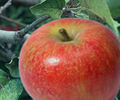 | Massachusetts, US | c. 1740 | Flesh yellowish white, crisp, sweet to subacid flavor, very good. Width 76–81 mm (3.0–3.2 in), height 68 mm (2.7 in). Stalk 22 mm (0.87 in). Tree vigorous. Very old variety for North America. Makes much juice. Cold storage 0oC 150 days. TRI DBH 160. | Cooking, Eating | Pick50 October 14. PickE mid-October. Use November–March |
| Ballinora[14] | England | <1898 | Golden yellow with red flush. Width 79 mm (3.1 in), height 56 mm (2.2 in). AM from RHS in 1898. | Cooking, eating | Use December–January | |
| Ball's Pippin[30][50] | England | <1920 | A green-yellow apple with red flush and russet. P Cox Orange x Sturmer Pippin. Flesh white, juicy, sweet, aromatic. Tree vigorous. AM from RHS in 1923. | Eating | PickE early to mid-October. Use January. | |
| Ballyfatten[6] |  | County Tyrone, Ireland | c. 1740 | A large, round apple with firm, dry, sweet, slightly tart white flesh. Excellent keeper. Scab and canker resistant. | Cooking, eating | PickE late September. Use October–November. |
| Baltimore (a.k.a. Baltimore Pippin)[9] |  | US | <1860 | Width 78 mm (3.1 in), height 62 mm (2.4 in). Stalk 15 mm (0.59 in). Flesh whitish, juicy, subacid. | Eating | Use December–April |
| Bancroft[6] |  | Ottawa, Ontario, Canada | Selected 1930. Introduced c.1935 | Width 70 – 80 mm. height 55–68 mm. Stalk 15 mm. Parentage Forest x McIntosh. Flesh white, crisp, tender, juicy. | Eating | PickE mid-October. Use November - December. |
| Banks[27][26] |  | Nova Scotia | 1880 | A red sport from Gravenstein | Eating, cooking, pie | |
| Barcelona Pearmain[12][51][13][28] |  | England | <1837 | One of the best dessert apples. Cells roundish oblate, axile. The tree is a free grower, but does not attain the largest size. | Eating, cooking | |
| Bardsey Island Apple | 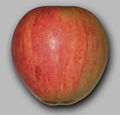 | Bardsey Island, Wales | 1998 | A medium-sized eating apple with a unique lemon aroma. Sweet and juicy. Skin color red over gold. Very disease resistant. Single tree discovered on Bardsey island in 1998, age of original tree unknown. May have monastic origins. | Eating | |
| Barkley Red Rome[52] |  | Bud mutation of Rome Beauty. | ||||
| Barnack Beauty[14][7][31] |  | Barnack, Northamptonshire, England | c. 1840, introduced c. 1870 | Medium-sized apple. Yellow, 25-75% flushed with orange red. AM from RHS in 1899. FCC from RHS in 1909. Width 67 mm (2.6 in), height 58 mm (2.3 in). Stalk 20–25 mm (0.79–0.98 in). Flesh; creamy white, very firm, crisp, fine-textured, juicy, subcaid to sweet. | Eating | PickE late September–early October. Use December–March |
| Barnack Orange[7] |  | England | 1904 | P Barnack Beauty x Cox Orange. Width 76 mm (3.0 in), height 67 mm (2.6 in). Stalk short. Flesh; creamy white, firm, coarse-textured, juicy, subacid, aromatic. | Eating | PickE late September–early October. Use November–February |
| Baronesa[18] | Brazil | Introduced 1997 | P Princesa x Fuji. Weight 130 g (4.6 oz). Flesh sweet, crisp. Tree vigorous. | Eating | ||
| Bascombe Mystery[7] | England | <1831 | A late keeping green apple. Width 68 mm, height 56 mm. Stalk short. Flesh pale yellow, fine-textured, juicy, subacid. | Eating | PickE early October. Use November - March | |
| Batul (a.k.a. Batulenka, Batulka, Batul-Alma ru. Batullen)[19][17] |  | Romania or Hungary | A green apple with red flush. Russet in stalk cavity. Width 50 mm (2.0 in), height 50 mm (2.0 in), weight 80 g (2.8 oz). Tree vigorous. Flesh acidic with poor aroma. | Eating | PickE mid- to late October. Use December–April. | |
| Baumanns Reinette (cs. Baumanova reneta,fr. Reinette Baumann, pl. Reneta Baumana, ru. Renet Baumana)[7][4][53][15][33][13][17][8] |  | Belgium | c. 1810 | Medium size. Skin brilliant crimson. Width 66 mm (2.6 in), height 52 mm (2.0 in). Weight 110 g (3.9 oz). Stalk 10–15 mm (0.39–0.59 in). Cells, oblate, axile, open. Flesh; crisp, subacid. First Class Certificate from RHS in 1878. Cold Storage 2oC 180 days. VitC 16. Density 0.83 | Cooking, eating | PickE late September. PickG early October. Use December–March |
| Baxter's Pearmain[7][12][13] |  | Norfolk, England | 1821 | A large dual purpose apple. Width 69 mm (2.7 in), height 60 mm (2.4 in). Stalk medium. Cells obovate, axile. The tree is hardy, vigorous, a most abundant bearer. Flesh; pale yellow, coarse-textured, dry, subacid. | Cooking, eating | PickE late September–early October; use November–March |
| Beach (a.k.a. Apple of Commerce)[27] |  | Arkansas, US | <1898 | A yellow apple with red overcolor, medium size. A late keeper. Stalk medium. Tree large, vigorous. Flesh: very firm, rather dry. | Eating | Pick late October. |
| Beacon[54] |  | Minnesota, US | Introduced 1936 | Lively, juicy flavor; good for baking. Does not keep very well. Parentage (Malinda x Duchess of Oldenburg)x(Malinda x Tetofsky) | Cooking, eating | PickE early September. Use September–October. |
| Beauty of Bath(de. Schöner aus Bath)[7][14][31][15][32][16][35][17] |  | Bailbrook, Batheston, Somerset, England | Introduced 1864 | Width 59–63 mm (2.3–2.5 in), height 44–51 mm (1.7–2.0 in). Stalk 9–12 mm (0.35–0.47 in). Deep red flush and streaks of red with a little russet. Early maturing but short season. Formerly grown commercially in England for local markets. FCC from RHS in 1887. Good flavor in its home climate if it is eaten soon after picking. Poor flavour if distributed long distances and stored for weeks, so now rare. Flesh; creamy white, soft, very juicy, subacid. VitC 14. | Eating | PickE early August; use early August |
| Beauty of Bedford[14][6] |  | Bedfordshire, England | <1913 | Width 64 mm (2.5 in), height 64 mm (2.5 in). P Lady Sudely x Beauty of Bath. Greenish yellow with orange flush. Flesh yellow, firm, juicy, sweet. | Eating | PickE mid-September; use September–October |
| Beauty of Hants[7][14] |  | Southampton, Hampshire, England | c. 1850 | A yellow apple with orange-red flush. Width 80 mm (3.1 in), height 70 mm (2.8 in). Stalk variable. Flesh very crisp, yellowish juicy, highly aromatic. Triploid. | Eating | PickE late September–early October; use November–February |
| Beauty of Kent[7][13][14] | Kent, England | introduced c.1820 | Old culinary apple, very irregular, ribbed. Width 90 mm (3.5 in), height 83 mm (3.3 in). Cells, roundish obovate, abaxile. AM from RHS in 1901. Flesh yellowish, tender, subacid. TRI | Cooking | PickE late September; use December–March | |
| Beauty of Stoke[14] |  | Nottinghamshire, England | <1889 | Width 70 mm, height 65 mm. Flesh yellowish, firm, dry, pleasant flavour. Tree vigorous. FCC from RHS in 1890. | Cooking, eating | PickE mid- to late October. Use January·March |
| Beauty of Wiltshire (a.k.a. Weisse Wachs Reinette)[28] |  | ? | <1800 | Yellow with red flush. Width 65 mm (2.6 in), height 56 mm (2.2 in). Stalk 9 mm (0.35 in). Flesh juicy, very acidic. | Cooking, eating | Use October–November |
| Bedfordshire Foundling[12][7][13] |  | Bedfordshire, England | c. 1800 | A yellow apple slightly flushed with red. An excellent culinary apple. Width 75–89 mm (3.0–3.5 in), height 65–88 mm (2.6–3.5 in). Cells obovate, abaxile. Stalk short. Flesh; creamy white, firm, juicy, subacid. | Cooking | PickE late September–early October; use December–March |
| Bedrika (a.k.a. Prisatka)[19] | Possibly Serbia | A green conical apple with red flush. Width 77 mm (3.0 in), height 65 mm (2.6 in). Weight 184 g (6.5 oz). Flesh white, sweet, with pleasant aroma. | Eating | |||
| Beefsteak[9] |  | Amesbury, Massachusetts, US | <1870 | Stalk medium. Flesh white, tender, crisp, juicy, subacid. Very good. | Eating | Use October–November |
| Beeley Pippin[7] | Derbyshire, England | Raisedc. 1880 | A yellow apple flushed (25–50%) with red. Width 73 mm (2.9 in), height 62 mm (2.4 in). Stalk short. Flesh yellow, juicy, sweet, aromatic. | Eating | Pick late August; use September–October | |
| Belle de Boskoop (cs. Boskoopské, de. Boskoop, Schöner von Boskoop) agm[55][24][4][31][7][16] |  | Boskoop, Netherlands | 1856 | Width 73–95 mm (2.9–3.7 in), height 67–87 mm (2.6–3.4 in), weight 205 g (7.2 oz). Stalk 10–25 mm (0.39–0.98 in). Flesh acid and aromatic. Tree vigorous. Particularly attractive blossom. AM from RHS in 1897. VitC 10–17. Density 0.83 TRI | Cooking, baking | PickE early October. PickG mid-October. Pickg September 23–October 15. Use January–April |
| Belle de Builts[28] | Builts, La Vienne, France | <1860 | A yellow apple with red flush. Width 68–74 mm (2.7–2.9 in), height 49–54 mm (1.9–2.1 in). Stalk 17 mm (0.67 in). Flesh white, crisp, juicy, aromatic, sweet. | Cooking, eating | Use January–April | |
| Belle de Pontoise(cs. Pontoiské, de. Schöner aus Pontoise, ru. Pontuazskaia krasvitța)[31][33][7][14][17] | 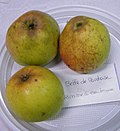 | France | 1869, introduced 1879 | Large flat-round apple. Greenish-yellow, 25–75% flushed with red. Biennial. Width 86 mm (3.4 in), height 64–67 mm (2.5–2.6 in). Stalk 15–20 mm (0.59–0.79 in). Flesh white, sweet, juicy. Tree vigorous. | Cooking. | PickE mid-October; use November–March |
| Bellefleur Kitaika (cs. Krasokvet Kitajka, pl. Bellfleur Kitajka) [17] |  | Russia | 1914 | Width 100 mm, height 85 mm. Flesh, white, soft, sweet. | Use October - December | |
| Belmont[9] |  | Pennsylvania, US | <1870 | Width 82 mm (3.2 in), height 67 mm (2.6 in). Stalk short to medium. Flesh yellowish, crisp, tender, juicy, aromatic. Very good. Tree vigorous, healthy, very productive. | Eating | Use November–February |
| Ben Davis(a.k.a. New York Pippin, Victoria Pippin, Victoria Red, Red Pippin, Kentucky Pippin, Baltimore Red, Baltimore Pippin)[10][27][26][56] | 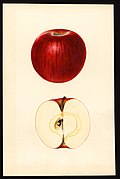 | Southeastern US | c. 1800 | Width 77 mm, height 80mm. Noted for keeping well prior to refrigerated storage, but flavour has been compared with cork. | Eating | Use January - June. |
| Bennet[9] |  | Herefordshire, England | <1870 | A cider apple. | Cider | |
| Benoni[7][10][9][57][26][13][58] |  | Massachusetts, US | <1832 | A small orange-yellow apple with red overcolour. Width 57–59 mm (2.2–2.3 in), height 53 mm (2.1 in). Stalk 16 mm (0.63 in). Cells obovate, axile, closed. Flesh yellow, firm, crisp, tender, juicy, subacid, good to very good. BB. DBH 110. | Eating | Pick50 August 23. PickE late August. Use August–September |
| Ben's Red[7][14] | Cornwall, England | c. 1830 | Medium to large apple. Slightly ribbed. Skin flushed and striped dark red. Flesh pale yellow, sweet, aromatic. P Devonshire Quarrenden Xbox Apple. Award of Merit from RHS in 1899. | Eating | PickE early September; use September. | |
| Bentley Sweet[10] |  | Virginia, US | <1850 | Flesh sweet. Tree vigorous, productive, an early bearer. | Eating | Use April–September |
| Berlepsch (see Frieherr von Berlepsch) | ||||||
| Berner Rosen (a.k.a. cs. Bernské růžové)[24][8] |  | Zurich, Switzerland | 1860 | A red apple. Height 57–62 mm (2.2–2.4 in), width 62–66 mm (2.4–2.6 in). Weight 110 g (3.9 oz). Stalk 20 mm (0.79 in). Flesh; soft, juicy, subacid. Cold storage 4oC 120 days. VitC 11. Density 0.78 | Eating | PickG late September–early October; use December–February |
| Bess Pool[14][31][7][13] |  | Nottinghamshire, England | 1824 | Round-conical apple. Flesh firm but tender, white, sweet, rather dry. Trees are shy bearers at first. Width 67–70 mm (2.6–2.8 in), height 58–63 mm (2.3–2.5 in). Stalk 10–15 mm (0.39–0.59 in). Cells ovate, axile, open or abaxile. | Eating | PickE early October; use November–February |
| Bethlemite[9] | 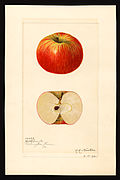 | US | <1860 | Width 78 mm (3.1 in), height 58 mm (2.3 in). Stalk 13 mm (0.51 in). Flesh juicy, subacid, aromatic. | Eating | Use December–March |
| Beverly Hills[11][18] | California, US | 1939, Introduced 1945.[59] | P Melba x Early McIntosh. Slightly tart flavor. Flesh white. Likes warm weather. MacIntosh style summer apple that is self fertile and well adapted to low chill conditions.[60] | Eating | ||
| Biesterfelder Renette[32][4][8] |  | Biesterfeld, Lippe, Germany | 1850 | A yellow apple striped with red. Width 60–75 mm (2.4–3.0 in), height 55–65 mm (2.2–2.6 in). Flesh white, crisp, juicy. Cold storage 2oC 120 days. | Eating | PickG mid-September. Use October–December |
| Bietigheimer[26][27] |  | Germany | <1870 | Fruit very large with russet. Width 110 mm (4.3 in), height 78 mm (3.1 in). Stalk 16 mm (0.63 in). Tree large, vigorous. Flesh white, firm, coarse, srisp, juicy, subacid, fair to good. | Use September–October | |
| Birgit Bonnier[61] |  | Sweden | 1992 | A cross between Cortland (apple) and Lord Lambourne. | ||
| Bismarck [7][24][14][26][27][16][35] |  | Victoria, Australia | 1870 | Large fruit with a yellow-green with red overcolour. Flesh crisp, juicy, subacid, fair to good. FCC from RHS in 1887. Width 65–85 mm (2.6–3.3 in), height 58–72 mm (2.3–2.8 in). Stalk 12 mm (0.47 in). | Cooking, juice. | PickE late September. Use November–February |
| Bittenfelder[4] |  | Baden-Württemberg, Germany | <1940 | Flesh; white, crisp, juicy, subacid. | Cider, juice | PickG late October. Use November–April. |
| Black Annette[9] |  | US | <1820 | Flesh white, tender, good. | Eating | Use November–December |
| Black Apple[9] |  | US | <1820 | Flesh white, good. | Eating | Use November–February |
| Black Ben Davis[27][26] |  | Arkansas, US | c. 1800 | A red mutation of Ben Davis. | Eating | Use January - April. |
| Black Gilliflower[10][27][26] |  | US | <1800 | Width 68 mm (2.7 in), height 74 mm (2.9 in). Stalk 15 mm (0.59 in). Flesh white, dry, subacid, good. Tree very productive. | Eating | Use November–March |
| Blackjon[11][8] |  | Washington, US | Introduced 1931 | Mutation of Jonathan. Cold storage 3-4oC 120 days. | Eating | |
| Blackmack[11] | British Columbia, Canada | Introduced 1930 | Mutation of Red McIntosh. | Eating | ||
| Black Oxford[9] |  | Maine, US | <1870 | Flesh white, dry, subacid, good. Tree a great bearer. | Eating | Use March–May |
| Black Sweet (a.k.a. Moore's Sweeting)[10] |  | US | <1820 | Width 82 mm (3.2 in), height 67 mm (2.6 in). Stalk 10 mm (0.39 in). Flesh yellow, dry, very sweet. Quality inferior. | Baking, cider | Use December–March |
| Blairmont[62] | Georgia, US | Cross made 1961 | A round to conical apple with 90% red overcolor. Moderately resistant to scab, fire blight, powdery mildew and black rot. DBH 112. Flesh: cream, juicy, subacid. | Eating | ||
| Blauacher Wädenswil[4] |  | Bern, Switzerland | Width 78 mm (3.1 in). Height 75 mm (3.0 in). Flesh; greenish-white, juicy, subacid. | Cider, juice | PickG late September. Use October. | |
| Bledsoe[10] |  | Kentucky, US | <1855 | A large apple. Stalk short. Flesh crisp, juicy, subacid, good. | Eating | Use September–April |
| Blenheim Orange (a.k.a. Emilia (in Ecuador) and Pennsylvania (in Colombia) cs. Blenheimská reneta, de. Goldrenette von Blenheim, pl. Blenheimska, ru. Renet blengheimskii, Renet zolotoi blengheimskii) agm[63][7][4][27][15][16][35][13][28][17][8] |  | England | Discovered c. 1740, introduced c. 1818 | Has greenish-yellow to orange skin streaked with red. Width 75–91 mm (3.0–3.6 in), height 60–70 mm (2.4–2.8 in), weight 165 g (5.8 oz). Stalk 10–20 mm (0.39–0.79 in). Cells open, obovate, axile. Flesh; aromatic, juicy. Distinctive nutty flavor excellent for cooking. The vigorous tree is slow to come into crop but then produces heavily. Cold storage 4oC 120 days. TRI VitC 13. Density 0.76 | Cooking, eating | PickE late September. PickG early October. Use November–January. |
| Bloody Ploughman[6] |  | Carse of Gowrie, Scotland | c. 1800 | A medium-sized, very dark red, heavily ribbed apple. Flesh white sometimes pink-streaked, crisp, juicy, mildly sweet. It is reputed to have got its name after a gamekeeper shot dead a ploughman caught stealing apples from the Megginch Estate. When his body was returned to his wife, she found stolen apples in his pockets and threw them onto a rubbish heap. One of the resulting seedlings bore apples of a deep, blood red. This tree gave rise to the cultivar that was named after the unfortunate ploughman.[64] | Eating | PickE mid-September. Use September - November. |
| Blue Pearmain[7][9][14][27][26] | 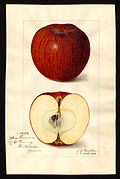 | US | c. 1800 | A yellow apple with dark red stripes. Width 70–75 mm (2.8–3.0 in). Height 63–70 mm (2.5–2.8 in). Steam short and stout. FCC from RHS in 1896. Flesh aromatic, spicy, subacid, very good. | Cooking, cider, eating | PickE early October; use November–December. |
| Blutapfel (a.k.a. Pomme Sanguinole, Purpurapfel)[28] |  | ? | <1820 | A yellow apple with red overcolor. Width 49–60 mm, height 45–54 mm. Stalk 6 mm. Flesh yellow tinted with red, juicy subacid. | Eating, Cooking | Pick October. Use December - May. |
| Bodil Neergaard[65][35] |  | Denmark | 1855 | A green oblong conical apple. Width 56–61 mm (2.2–2.4 in), height 70–75 mm (2.8–3.0 in). Stalk 10 mm (0.39 in). Flesh; white, juicy, spicy. | Eating, cooking | Pick October; use Januar–March |
| Böhmer (a.k.a. Edel-Böhmer)[28] |  | Tyrol | <1857 | Green with red flush. Width 75 mm (3.0 in), height 55 mm (2.2 in). Stalk 13 mm (0.51 in). | Eating | Use December–March |
| Böhmischer Rosenapfel[28] |  | Bohemia, Germany | <1800 | A large apple. Width 81 mm (3.2 in), height 56 mm (2.2 in). Stalk 12 mm (0.47 in). Flesh juicy, sweet. | Eating, cooking | Use August–September |
| Bohnapfel (a.k.a. Grosser Rheinischer Bohnapfel, cs. Strýmka, pl. Grochówka)[4][8] |  | Germany | <1800 | Width 55 mm (2.2 in), height 55 mm (2.2 in), weight 100 g (3.5 oz). Stalk 10–20 mm (0.39–0.79 in). Flesh; acid, crisp, juicy. Cold storage 2oC 210 days. Density 0.80 TRI | Cooking, cider | PickG late October–early November; use March–May |
| Boiken (cs. Boikovo)[7][4][24][26][35][8] |  | Bremen, Germany | 1828 | Culinary apple. Width 68–82 mm (2.7–3.2 in), height 56–68 mm (2.2–2.7 in). Weight 125 g (4.4 oz). Stalk 17–23 mm (0.67–0.91 in). Flesh white, firm, crisp, tender, juicy, subacid to acid, good. Cold storage 0oC 150 days. VitC 10. Density 0.85 | Cooking, drying, juice | PickE mid-October. PickG mid–late October; use February–May |
| Bonum (a.k.a. Magnum Bonum)[9][26][27] |  | US | 1828 | Width 77 mm (3.0 in), height 57 mm (2.2 in). Stalk 20 mm (0.79 in). Flesh white, firm, tender, aromatic, juicy, mild subacid, very good. | Eating | Use September–December |
| Borgovskoje[38] | Russia | <1860 | A sweet yellow apple. | Eating | Pick late August | |
| Borovitsky (see Duchess of Oldenburg) | ||||||
| Borsdorfer see Edelborsdorfer | ||||||
| Börtlinger Weinapfel[4] |  | Baden-Württemberg, Germany | 1827 | Flesh; greenish-white, juicy, acid. Tree vigorous. | Cider, juice | PickG mid-October. Use October–November. |
| Bottle Greening[9] |  | Green Mountains, US | <1850 | Produces large fruit. Has thick skin. Flesh white, subacid. | Eating, cider | Use January–February |
| Bough (see Sweet Bough) | ||||||
| Bountiful[31] |  | Kent, England | Width 76 mm (3.0 in), height 57 mm (2.2 in). Stalk 20 mm (0.79 in). A yellow apple flushed (0–25%) with red. Flesh, fairly juicy, fairly tender. | Cooking, Eating | Pick late September; use September–January | |
| Bow Hill Pippin[14][7] | Bow Hill, Kent, England | introduced 1893 | Golden yellow with slight flush. Width 70 mm (2.8 in), height 60 mm (2.4 in). AM from RHS in 1893. Flesh yellow, firm, juicy, good. | Eating | Use November–February | |
| Brabant Bellefleur(a.k.a. Brabantsche Bellefleur)[14][13][39] | France? | <1830 | A yellow apple with red flush and stripes. Width 71 mm, height 67 mm. Stalk 10mm. Cells closed, elliptical. AM from RHS in 1901. Flesh crisp, yellow, acid, aromatic. | Cooking | Use December–April | |
| Braddick Nonpareil[13] |  | England | <1828 | A medium-sized roundish apple. Width 66 mm, height 55 mm. Stalk short. Cells, ovate, axile. Flesh yellowish, subacid, aromatic. More sweet and tender than the Old Nonpareil. | Eating | PickE mid October. Use November - April. |
| Braeburn[66][67][44][8] |  | New Zealand | introduced 1952 | Width 76 mm, height 69 mm. Chance seedling. Flesh pale cream, firm, crisp, juicy. Red overcolor 69%. Ripens 19 days after Golden Delicious. Not susceptible to bitter-pit. The fruit is widely sold commercially in the United Kingdom. Cold Storage 1oC 180 days. SS 13.8 - 14.7 TA 0.53 - 0.86. | Eating | Pick 45 October 16. Pick55 October 5. Pick at the end of late May in New Zealand. |
| Bramley (Bramley's Seedling) agm[68][16][7][35][13] |  | Nottinghamshire, United Kingdom | 1809 | Most widely sold cooking apple in the United Kingdom. Triploid. Width 83–86 mm (3.3–3.4 in), height 66–70 mm (2.6–2.8 in). Stalk 10–20 mm (0.39–0.79 in). Cells round, axile, open. Large sized fruits with waxy skin, green with a red flush, which must be peeled before use. A favorite ingredient in many traditional British puddings.[69] TRI | Cooking, juice, cider. | PickE mid-October. Use November–February. |
| Brasil (a.k.a. Bruckner, Bruckner do Brasil)[18] | Brazil | 1940s | Fruit large, resembles Delicious. Tree vigorous. | Eating | ||
| Brauner Matapfel[15] |  | Germany | <1800 | A yellow apple with redbrown flush. Width 65 mm (2.6 in), height 55 mm (2.2 in). Stalk 7 mm (0.28 in). Flesh whitish-yellow, sweet, subacid. Quality cooking good, eating fair. | Cooking | Pick mid-October; use December–May |
| Bravo de Esmolfe | Esmolfe, Penacova, Portugal | 18th century | A small, juicy and sweet apple, considered one of the best Portuguese apples | Eating | ||
| Breakey[11] | Manitoba, Canada | Introduced 1935 | Fruit medium size, red and scarlet. Flesh white, melting, juicy, spicy. | Cooking, eating | Use September–November | |
| Breda Reinette (a.k.a. Reinette von Breda, Reinette de Breda, Nelguin, Reinette Nelguin)[28][70] |  | Netherlands | <1760 | Width 65 mm (2.6 in), height 56 mm (2.2 in). Stalk 7 mm (0.28 in). Flesh yellowish, juicy, aromatic. | Cooking, eating | Use December–March |
| Breedon Pippin[28] | England | 1801 | Sweet flavor. Originally raised by a parson in Berkshire. Rare. | Eating | ||
| Brettacher[32][4] |  | Brettach, Württemberg, Germany | A yellow apple striped with red. Width 70–85 mm (2.8–3.3 in), height 50–60 mm (2.0–2.4 in). Flesh white, juicy. | Eating | PickG mid–late October. Pickg October 15–30. Use December–May. | |
| Breuhahn(a.k.a. Geheimrat Breuhahn, cs. Breuhahnovo)[4][32][8] |  | Geisenheim, Germany | 1895 Introduced 1934 | Width 57–63 mm (2.2–2.5 in), height 45–53 mm (1.8–2.1 in), weight 93 g (3.3 oz). Stalk 17–25 mm (0.67–0.98 in). Flesh: yellowish white, juicy, subacid. Cold storage 1oC 180 days. VitC 8–14. Density 0.74 | Cooking, eating | PickG late September–early October; use October–April |
| Briar Sweet (see Pound Sweet) | ||||||
| Brina | Italy | 1998 | Resistant to scab. Spreading habit with intermediate vigor; full flowering season is medium-late, production is heavy, fruit is medium or medium-large, with smooth skin; white lenticels, no russet, excellent taste characteristics. Ripens first week of October (Trentino). | Eating | ||
| Britegold[43] | Ontario, Canada | Introduced 1980 | A bright yellow apple. Flesh cream-colored, tender, juicy. Biennial tendency. Resistant to apple scab. | Eating, pie | ||
| Broad Eyed Pippin[7][13] |  | England | <1700 | A yellow apple with some light brown flush. Width 93 mm (3.7 in), height 70 mm (2.8 in). Stalk short. Cells obovate, axile, open. Flesh white, acid. | Cooking, cider. | PickE late September; use November–January |
| Brownlee's Russet[14][7][31][32][13] |  | Hempstead, Hertfordshire, England | c. 1848 | Green with red flush, covered with russet. Width 70–74 mm (2.8–2.9 in), height 58–61 mm (2.3–2.4 in). Stalk 8–12 mm (0.31–0.47 in). Cells pointed ovate, axile, open. Flesh greenish white, juicy, acid, nutty flavour. | Eating | PickE mid-October; use December–March |
| Buckingham (a.k.a. Kentucky Queen, Lexington Queen)[71][27][26] |  | US, probably southern states | <1817 | Width 87–93 mm (3.4–3.7 in), height 67–78 mm (2.6–3.1 in). Stalk 11–21 mm (0.43–0.83 in). Flesh coarse, juicy, subacid, fair to good. | Eating | Use November–February |
| Buff[10] |  | US | <1830 | Very large. Stalk 19 mm (0.75 in). Flesh, white, tender. | Eating | Use November–March |
| Bullock[27] |  | New Jersey, US | <1805 | Width 59 mm (2.3 in), height 55 mm (2.2 in). Stalk 23 mm (0.91 in). Flesh firm, crisp, tender, juicy, aromatic, subacid, very good to best. Tree not large. | Eating | Use October–January |
| Buncombe(a.k.a. Red Winter Pearmain)[10] |  | US | <1860 | A medium to large sized yellow conical apple striped with red. Flesh yellow, juicy, mild subacid, good. | Eating, Cooking | Use December - January |
| Burchardt's Reinette[13][28] |  | Nikita, Crimea | <1860 | A roundish-oblate apple. Width 65 mm, height 48 mm. Cells roundish obovate, axile. Flesh white, tender, crisp, juicy. | Eating. | PickE early October. Use November - December. |
| Bushey Grove[7][30] |  | Hertfordshire, England | 1897 | A greenish-yellow apple with red flush (25–75%). P Alexande x Dumelow. AM from RHS in 1922. Width 78 mm (3.1 in), height 66 mm (2.6 in). Stalk short. Flesh white, juicy, acid. | Cooking, pie | PickE late August–early September; use October–December |
| Byfleet Seedling[7] |  | Surrey, England | 1915 | Large cooking apple; width 96 mm (3.8 in), height 76 mm (3.0 in). | Cooking | PickE early October. Use October–February. |
| Byford Wonder[14] |  | Herefordshire, England | <1893 | Yellow with russet dots. Very large. Tree very vigorous. AM from RHS in 1893. | Cooking | PickE early October. Use November–December. |
C
[edit]| Common name | Image | Origin | First developed | Comment | Use | Pick/Use period |
|---|---|---|---|---|---|---|
| Cabashea[9][27] |  | New York, US | <1851 | A large oblate apple. Width 100 mm (3.9 in), height 68 mm (2.7 in). Stalk 19 mm (0.75 in). | Cooking | Use September–October |
| Čačanska pozna[72] | Serbia | Introduced 1971 | P Starking x Jonathan. Width 79 mm (3.1 in), height 66 mm (2.6 in), weight 200 g (7.1 oz). Stalk medium. Diploid. | Pick late September–early October | ||
| Čadel[72] | Serbia | Introduced 1984 | P Golden Delicious x Jonathan. Width 78–82 mm (3.1–3.2 in), height 78–82 mm (3.1–3.2 in), weight 250–275 g (8.8–9.7 oz). Stalk 45 mm (1.8 in). Flesh firm, crisp, juicy, acid. | Pick late September–early October | ||
| Cal-King[11] | California US | 1942 | P unknown. | |||
| Calville Blanc d'hiver(cs. Kalvil bílý zimní)[7][32][33] | 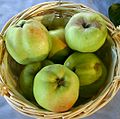 | France | <1598 | Noted for unusual looks (somewhat lumpy on the side) but excellent reward when tried. Noted for having unusually high vitamin C content. Apple of choice for tarte tatin in France. Width 75 mm (3.0 in), height 65 mm (2.6 in). Stalk variable. Flesh white, juicy, sweet, aromatic. C 32. | Cooking, eating | PickE third week of October; use November–March |
| Calville Rouge D'Automne(cs. Kalvil cerveny podzimni, de. Roter Herbst Kalvil, pl. Jablko malinow, ru. Osennii krasnîi kalvil.)[12][13][17] |  | France | 1670 | A culinary apple of inferior quality in England. Cells ovate, axile. | Cooking, eating | PickE late September. Use October–November. |
| Calville Rouge D'Ete[12] | France | <1800 | A culinary apple of second-rate quality. | Cooking, eating | ||
| Calville Rouge D'Hiver[12][7][58][28] |  | France | <1800 | A culinary apple of second-rate quality. Width 75 mm (3.0 in), height 76 mm (3.0 in). Stalk long. Flesh white, soft, juicy, sweet. | Cider, cooking, eating | Pick early October; use December–March |
| Calville Saint Sauveur[28][16][13] |  | France | 1839 | Yellow with red flush. Width 74 mm (2.9 in), height 61–71 mm (2.4–2.8 in). Stalk 12–18 mm (0.47–0.71 in). Cells elliptical or ovate, pointed, abaxile. | Eating | Pick October. Use October–February. |
| Cambusnethan Pippin[7] |  | Stirlingshire, Scotland | c. 1750 | A yellow apple with red flush (50–75%). Width 70 mm (2.8 in), height 52 mm (2.0 in). Stalk medium. Flesh white, sweet, aromatic. | Eating, cooking | PickE mid- to late September; use October–December |
| Cameo[44] |  | Washington State, US | 1980s | Width 78 mm, height 70 mm. Existence owed to freak accidental crossing of two most popular apples in world: Red and Golden Delicious. Retains prongs on bottom of latter parent but has flavor more resembling Golden. | Eating | Pick45 October 20. Pick55 October 8. |
| Campanino |  | Modena, Italy | Before 1751 (documented) | Fruits have firm, crisp flesh with a rather acid flavor | Cooking | PickE late October. Use January–March. |
| Campfield (a.k.a. Newark Sweeting)[9][27][10] | New Jersey, US | <1817 | A cider apple. Biennial. | Cider | Use November–July | |
| Canada Reinette (see Reinette du Canada) | ||||||
| Cannon Pearmain[9][10][27] |  | Possibly North Carolina, US | <1851 | A medium size, yellow apple with red flush. Flesh yellow, subacid, very good. | Eating | Use December–March |
| Capital[10] |  | Indiana, US | <1850 | Width 65 mm (2.6 in), height 57 mm (2.2 in). Stalk 11 mm (0.43 in). Flesh yellow, juicy, subacid. | Eating | Use December–January |
| Caraway Russet (see Fenouillet Gris) | ||||||
| Carícia[18] | Brazil | Introduced 1995 | P Prima x Anna. Flesh subacid, good. Tree vigorous. | Eating | ||
| Cardinal (a.k.a. Kiarolkowski, Peter the Great)[14] | Russia | <1880 | AM from RHS in 1896. Flesh soft, white, juicy, sweet, aromatic. | Eating | PickE mid-August. Use August–September | |
| Carlisle Codlin[7][13] |  | England | <1830 | Yellow apple with no overcolour. Width 65 mm (2.6 in), height 58 mm (2.3 in). Stalk very short. Flesh, white, tender juicy, subacid. | Cooking | PickE early September; use October–November |
| Carlough[27] |  | New York, US | <1899 | Flesh whitish, tender, juicy, subacid, good. | Eating | Use November–April |
| Carlton[11] |  | Geneva, New York, US | Introduced 1923 | P Montgomery x Red Astrachan. Ripens 1 month later than Red Astrachan. Flesh white, tender, juicy, subacid. Tree vigorous, annual bearer. | PickE late August. Use August–October. | |
| Carola (a.k.a. Kalco)[4][8] |  | Germany | 1962 | Width 74–85 mm (2.9–3.3 in), height 60 mm (2.4 in), weight 135–220 g (4.8–7.8 oz). Stalk 5–20 mm (0.20–0.79 in). Cold Storage 2oC 90 days. Density 0.79 | Cooking, eating | PickE mid-September; use September–December. |
| Carolina Red June[57][27][9][10] (a.k.a. Red June, Georgia June) |  | Tennessee, US | c. 1810 | Very popular Civil War-era Southern apple. Flesh juicy, brisk, subacid. Does beautifully in humid weather. Good choice for backyard gardener in subtropical climate, though hardy as far north as zone 5. | Cooking, Eating | Pick late July–early August; use August–October |
| Carpentin Reinette (a.k.a. Carpentin)[28] |  | France or Germany | <1800 | Gelb with red stripes. Width 59 mm (2.3 in), height 44 mm (1.7 in). Stalk 15 mm (0.59 in). | Cooking. | Use December–March |
| Carroll[73] | Manitoba, Canada | Selected 1947, introduced 1961. | Resembles a highly colored Melba. Tree dwarfish to medium, winter-hardy. | Eating | Pick late August–early September. | |
| Carswell's Orange[7] |  | Surrey, England | 1938 | A yellow apple with red flush (25–75%). P Cox Orange x unknown. Width 67 mm (2.6 in), height 63 mm (2.5 in). Stalk medium. Flesh white, juicy, aromatic. | Eating | Pick mid-September; use September–November |
| Carter's Blue |  | Alabama, US | 1840s | Medium to large, roundish oblate; skin green or greenish yellow washed with dull red with darker red broken tripes, covered with a heavy bluish bloom. Crisp, juicy, sugary, aromatic, mild subacid. Foliage also has a blue hue. Once widely grown in the American South, then thought extinct. Reintroduced to America in 1994 after being discovered at the National Fruit Trust in Kent, England, where it had been added in 1947 from a collection in Rhone, France, after it had been acquired around 1860 from the Fruitland Nursery in Augusta, Georgia.[74] | Eating, cooking | PickE early October. Use October–February. |
| Carver (a.k.a. White Carver)[9] |  | Pa. US | <1875 | Stalk short. Flesh yellow, juicy, tender, vinous, subacid. Tree productive. | Eating | Use August |
| Catline (a.k.a. Gregson Apple)[9] |  | Maryland, US | <1875 | Below medium size. Flesh tender, juicy, sweet. Tree slow growth. | Eating | Use October–December |
| Catshead[7][13] |  | England | <1700 | Sharp flavor. Lumpy shape and electric green coloring. Width and height 86 mm (3.4 in). Stalk short. Cells ovate, abaxile. Known to have been a variety planted in early Virginia by settlers as well as native England. Extremely rare in native United Kingdom; occasionally still found growing in southern United States. | Cooking | PickE early October. Use October–January. |
| Cauley[11] | Mississippi, US | Introduced 1942 | P unknown. A large apple. Flesh yellow, crisp, juicy. Tree yields heavily. | Cooking, jelly | ||
| Celestia[10] |  | Ohio, US | <1850 | Width 83 mm (3.3 in), height 75 mm (3.0 in). Stalk 21 mm (0.83 in). Flesh subacid, sprightly, spicy, aromatic. | Cooking, eating | Use September |
| Cellini (fr. Cellini, de. Cellini, ru. Cellini)[7][24][29][25][15][35][13][28][17] |  | England | <1843 | Width 70–86 mm (2.8–3.4 in), height 56–74 mm (2.2–2.9 in). Stalk 10–20 mm (0.39–0.79 in). Cells round to obovate, axile, open. Flesh; white, soft, subacid. | Eating, cooking | PickE mid–late September; use October–December |
| Chailleux[28][34] |  | Bretagne, France | <1870 | Width 66–85 mm, height 54–72 mm. Stalk 10mm. Flesh yellowish-white, juicy, subacid. | Eating, cooking, juice | Use November - January |
| Champagnerrenette (see Reinette de Champagne) | ||||||
| Champion (a.k.a. Shampion, Sampion)[4][8] |  | Czechoslovakia | c. 1960, introduced 1976 | A greenish yellow apple with red flush. Width 72 mm (2.8 in), height 65 mm (2.6 in). Weight 180 g (6.3 oz). Stalk 40 mm (1.6 in). P Golden Delicious x Cox Orange Pippin. Attractive color. This tree bears attractive fruit, extra-large sized, deep Flesh; creamy white, juicy, and subacid. Keeps fresh for a long time. Starts bearing at a young age. Cold storage 2oC 120 days. VitC 8. | Eating | PickG early to mid-October. Use October–February. |
| Champlain[27] |  | US | < | A grennish yellow apple. Width 83 mm (3.3 in), height 75 mm (3.0 in). Stalk 21 mm (0.83 in). Flesh white, very tender, juicy, subacid. Quality: eating good, cooking excellent. | Eating, cooking | Use August–October |
| Charden[4][8] |  | France | Width 80 mm, height 65 mm. Parentage Golden Delicious x Reinette Clochard. Flesh; subacid. Cold storgage 1oC 150 days. TRI | Cooking, eating | PickG October. Use November–March. | |
| Charlamoff[26][27] |  | Russia | <1880 | Yellow with red flush. Tree small. Flesh white, coarse, juicy, subacid, good. | Eating | Pick August; use August |
| Charlamowsky (see Duchess of Oldenburg) | ||||||
| Charles Eyre[7] |  | Berkshire, England | Introduced 1911 | A greenish-yellow apple. Width 102 mm (4.0 in), height 90 mm (3.5 in). Stalk short. Flesh white, soft, dry, acid. | Cooking, pie | PickE mid-September; use September–November |
| Charles Ross[7][14]agm[75][31][8] |  | Berkshire, England | 1890s | FCC from RHS in 1899. Orange to red. Width 80 mm (3.1 in), height 70 mm (2.8 in). Stalk 10 mm (0.39 in). Best cooked early in season. Good flavor, and sweet when eaten later in season. Cold storage 3oC 90 days. | Multi-purpose | PickE mid-September; use October–December |
| Chataigner(a.k.a. Martrange, Maltranche Rouge)[33][28][34] |  | Normandie, France | <1400 | A green apple with russet and red overcolor (50-70%). Width 72–74 mm (2.8–2.9 in), height 55–67 mm (2.2–2.6 in). Stalk 7–13 mm (0.28–0.51 in). One of the oldest apple varieties in the world. | Cooking, eating, cider. | PickE late October. Use December–April. |
| Chaxhill Red[13] |  | Gloucestershire, England | >1873 | A roundish oblate red apple. Width 63 mm (2.5 in), height 52 mm (2.0 in). Stalk short and stout. Cells roundish obovate, axile, open. Flesh tender, subacid. | Eating, cider | |
| Cheddar Cross[7][76] |  | Long Ashton, England | Raised 1916, selected 1946, introduced 1949. | Green apple with red flush. Width 60 mm (2.4 in), height 50 mm (2.0 in). P: Allington Pippin x Star of Devon. Flesh yellow, juicy, sharp. | Eating | PickE late August. Use August–September. |
| Cheese[9] |  | Pa. US | <1870 | Flesh white, tender, subacid. Good. Tree vigorous, bears annually. | Eating | Use November–February |
| Cheeseborough[10] |  | US | <1840 | One of the largest and one of the poorest of the russet apples. Flesh dry, subacid, sweet. | Cooking | Use November–December |
| Chelmsford Wonder[7][77][14][78] |  | Essex, England | c. 1870 | A large long keeping yellow-skinned apple with diffuse orange pink flush. FCC from RHS in 1891. Width 75–81 mm (3.0–3.2 in), height 61–68 mm (2.4–2.7 in). Stalk: short and stout. Still grown in Essex orchards including Lathcoats Farm Shop. Flesh; creamy white, firm, tough, fine-textured, juicy, subacid. P Dumelow x ? | Cooking | PickE early October; use November–February |
| Chenango[9](a.k.a. Chenango Strawberry)[26][27] |  | N.Y. US | <1850 | Width 72 mm (2.8 in), height 72 mm (2.8 in). Stalk 14 mm (0.55 in). Flesh white, firm, tender, juicy, mild subacid, aromatic, good to very good. | Eating | Pick45 August 14. PickE early September. Use September–October |
| Chester (a.k.a. Chester Redstreak)[9] |  | Pennsylvania, US | <1850 | Medium size. Flesh white, tender, juicy, subacid, aromatic. | Eating | Use November–December |
| Chestnut[11][79] | Minnesota, US | Introduced 1946 | P Wealthy x unknown. Flesh nutlike flavor. Tree vigorous, productive. | |||
| Chieftain[8] |  | Iowa, US | Raised 1917, introduced 1967 | Width 65–80 mm, height 65–75 mm. Stalk 18–35 mm. Flesh white, firm, crisp, juicy, sweet. Cold storage 3-4oC 120 days. | ||
| Chiver's Delight[31][7] |  | Histon, Cambridgeshire, England | 1920s | Medium to large oblate apple. Red flush over greenish yellow skin. Width 68 mm (2.7 in), height 59 mm (2.3 in). Stalk long. Flesh; creamy white, firm, fine-textured, juicy, sweet. Flavor can be variable but at its best is very well balanced. Grown by Chivers (now a brand of Premier Foods) for apple sauce. | Multi-purpose | Picke mid-October. Use November–January. |
| Chorister Boy[7] |  | Wiltshire, England | <1890 | A yellow apple with red flush. Width 66 mm (2.6 in), height 60 mm (2.4 in). Stalk medium. Flesh white, juicy, subacid. Particularly attractive blossom. | Eating | PickE late September–early October; use November–December |
| Christmas Pearmain[7] |  | England | 1893 | A yellow apple with red flush (50–75%). Width 63 mm (2.5 in), height 67 mm (2.6 in). Stalk short. Flesh yellow, crisp, subacid, aromatic. | Eating | PickE early October. Use November–January |
| Cissy (see Tamplin) | ||||||
| Citron d'Hiver (see Winter Zitronenapfel) | ||||||
| Clarke (a.k.a. Clarke Beauty)[27] |  | New York, US | <1900 | Flesh tender, juicy, subacid. | Eating | Use October–January |
| Claygate Pearmain [7][14] [31][13] |  | Surrey, England | <1821 | Suitable for northerly, cold, wet climates: rich, nutty flavor. FCC from RHS in 1921. Width 67–70 mm (2.6–2.8 in), height 59–67 mm (2.3–2.6 in). Stalk 10–18 mm (0.39–0.71 in). Flesh, crisp, greamy white tinged green, subacid, aromatic. Cells obovate to elliptical, axile. TRI | Eating | PickE early October; use December–February |
| Clayton[10] |  | Indiana, US | <1850 | Width 84 mm (3.3 in), height 70 mm (2.8 in). Stalk 14 mm (0.55 in). Flesh yellow, subacid. | Cooking | Use November–March |
| Cleopatra (see Ortley) | ||||||
| Clivia[4][8] |  | East Germany | 1964 | Geheimrat Dr. Oldenburg x Cox's Orange Pippin. Width 64–80 mm (2.5–3.1 in), height 56 mm (2.2 in), weight 100–183 g (3.5–6.5 oz). Stalk 15–30 mm (0.59–1.18 in).Cold storage 2oC 120 days. | Eating | PickE late September. PickG mid-October. Use October–April |
| Close[7][25] | Virginia, US | Selected 1928, Introduced 1938 | A greenish-yellow apple with red stripes. Width 65–75 mm (2.6–3.0 in), height 67–72 mm (2.6–2.8 in), TRI | Eating | PickE early August; use August. | |
| Cludius Herbstapfel[80] |  | Germany | <1860 | A green apple. Width 80 mm (3.1 in), height 64 mm (2.5 in). Flesh juicy, subacid. | Eating | PickE mid-September; use September–October. |
| Cockle Pippin(a.k.a Nutmeg Pippin, de. Hahnen Pepping)[7][13][28] |  | Surrey, England | c. 1800 | A greenish yellow apple. Width 62 mm (2.4 in), height 59 mm (2.3 in). Stalk medium. Cells elliptical, axile, open. Flesh, firm, white, dry, sweet. | Eating | PickE early–mid-October; use December–March. |
| Coffelt[27] |  | US | Flesh whitish, firm, tender, juicy, subacid, good. | Eating | Use January–May | |
| Cogswell (a.k.a. Cogswell Pearmain)[9] |  | Connecticut, US | c. 1755 | Width 84 mm (3.3 in), height 63 mm (2.5 in). Stalk 16 mm (0.63 in). Flesh yellow, juicy, subacid, aromatic. Very good to best. | Eating | Use December–March |
| Collamer[26][27] |  | New York, US | c. 1895 | A sport of Twenty Ounce. Width 105 mm (4.1 in), height 95 mm (3.7 in). Stalk 17 mm (0.67 in). | ||
| Collins[27] (a.k.a. Apple of Commerce) |  | Fayetteville, Arkansas, US | 1885 | Width 78 mm (3.1 in), height 59 mm (2.3 in). Stalk 19 mm (0.75 in). Flesh white, crisp, firm, subacid, fair to good. Tree vigorous. | Eating | PickE late October. Use January–June |
| Colora Red York[11] (a.k.a. Red York Imperial) | Colora, Cecil County, Maryland | Discovered 1933. Introduced 1935. | A bright red apple. Bud mutation of York Imperial. Assigned to Bountiful Ridge Nurseries, Maryland. | |||
| Colton[27] |  | Massachusetts, US | c. 1840 | A yellow apple. Flesh juicy, mild subacid. | Eating | Use August |
| Colvert[10] |  | US | <1850 | A large apple. Flesh white, juicy, subacid. | Eating | Use October–November |
| Conard[11] | Missouri, US | Introduced 1935 | P Ben Davis x Jonathan. Ripens one week after Jonathan. Tree vigorous, resistant to disease. | Eating | ||
| Connel Red Fireside[81] | Wisconsin, US | Discovered 1949, Introduced 1957 | Bud mutation of Fireside. Fruit red, large. Tree very hardy, productive. | |||
| Constantine[26][27] |  | Europe | <1873 | Constantine is very similar to Alexander, but ripens later and keeps longer. Width 91 mm (3.6 in), height 69 mm (2.7 in). Stalk 23 mm (0.91 in). Flesh, white, firm, coarse, tender, juicy, subacid, fair to good. | Eating | Use September–November |
| Cook's Favorite[10] |  | US | <1850 | Flesh yellow, subacid. Stalk long. | Cooking | Use September |
| Cooper[10][9][27] | Connecticut, US | <1796 | Width 86 mm (3.4 in), height 65 mm (2.6 in). Stalk 18 mm (0.71 in). Flesh juicy, subacid, vinous, sweet. Good. | Eating | Use October–December | |
| Cooper Early White[9] |  | Possibly Illinois, US | <1870 | Flesh white, crisp. | Eating | Use September–October |
| Cooper Market[9][27][82] |  | Possibly New Jersey, US | <1804 | Width 66 mm, height 59 mm. Flesh white, tender, subacid, fair to good. Tree vigorous. | Eating | Use December–May |
| Cornell Fancy[9] | 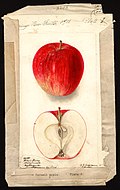 | Pennsylvania, US | <1870 | Stalk medium. Flesh white, tender, crisp, juicy, subacid. Very good. Tree vigorous. | Eating | |
| Cornish Aromatic[7][31][13] |  | Cornwall, England | very old | Large yellow. High-quality dessert apple. Width 64–77 mm (2.5–3.0 in), height 58–69 mm (2.3–2.7 in). Stalk 18–21 mm (0.71–0.83 in). Cells obovate, axile. Flesh yellowish, firm, crisp, juicy, highly aromatic. | Eating | PickE mid-October; use December–March |
| Cornish Gilliflower[7][31][13][58] |  | Cornwall, England | Introduced 1813 | Discovered as accidental seedling. Shy bearer. Width 68–70 mm (2.7–2.8 in), height 68–70 mm (2.7–2.8 in). Stalk 18 mm (0.71 in). Cells roundish obovate, axile or abaxile. Partial tip bearer. Flesh yellow, aromatic, sweet. Particularly attractive blossom. | Eating | PickE mid-October; use November–March |
| Coronation[7] |  | Sussex, England | 1902 | A yellow apple with red flush (50–75%). Width 81 mm (3.2 in), height 63 mm (2.5 in). Stalk long. AM from RHS in 1902. Flesh white, soft, dry, sweet. | Cooking, eating | Pick mid-September; use September–December |
| Cortland[7][25][26][8] |  | Geneva, New York, US | 1899. Introduced 1915. | Width 73 mm (2.9 in), height 57–62 mm (2.2–2.4 in). Classic red coloration, nice crunch. Flesh; white, juicy, crisp. P Ben Davis x McIntosh. Tree early and annual bearer, very hardy. Cold storage 3oC 90 days. | Eating | Pick45 September 15. Pick55 September 1. |
| Coryphée[83] | Sint-Truiden, Belgium | 2013 | Parentage Rubinstep x Nicoter. | eating | Pick early to mid September. | |
| Cosmic Crisp[67] |  | Washington, United States | Cross made 1997. Became available commercially in 2019. | Width 84 mm (3.3 in), height 79 mm (3.1 in). Stalk 26 mm (1.0 in). Weight 290–300 g (10–11 oz). P Enterprise x Honeycrisp. Flesh: crisp, firm, juicy. SS 12.9–14.6, TA 0.60–0.83. | Eating | Ripens four weeks after Gala. |
| Cottenham Seedling[7] |  | Cambridgeshire, England | <1923 | P Dumelow x unknown. Width 80 mm (3.1 in), height 67 mm (2.6 in). Stalk short to medium. Flesh white, firm, juicy, acid. | Cooking | PickE late September–early October; use November–March |
| Coulon's Reinette see Reinette Coulon | ||||||
| Court of Wick[13] |  | England | <1790 | A green apple with red overcolor (0-20%). Width 61 mm, height 54 mm. Stalk 13 mm. Cells roundish elliptical, axile. Flesh yellow, tender, crisp, juicy. | Eating | Pick October. Use October - March. |
| Court Pendu Plat (fr. Court Pendu Rouge)[7][31][32][16] |  | France | 1613 | Extremely old variety, may date from as early as Roman times. Width 61–67 mm (2.4–2.6 in), height 45 mm (1.8 in). Stalk 8–10 mm (0.31–0.39 in). Popular during the Victorian era. Yellow to light green, flushed with red (0–75%). Particularly attractive blossom. | Eating, cooking, baking, drying, juice. | PickE mid-October; use December–April |
| Cowan's Seedling[13] | England | A small apple, yellow with red flush. Stalk very short. Cells obovate, abaxile. Flesh juicy, sweet, pleasant flavour. | Eating | Use October | ||
| Cowarne Quoining[13] | Herefordshire, England | 1826 | Width 65 mm (2.6 in), height 65 mm (2.6 in). Stalk short and slender. Cells large, symmetrical, obovate, axile, open. Flesh juicy, sweet and of good flavour. | Eating | Use January–March | |
| Cox's Orange Pippin (cs. Coxova reneta, fr. Orange de Cox, pl. Koksa Pomaranczowa, ru. Renet Coxa)[7][31][4][27][33][16][34][13][17][8] |  | England | 1829 | One of the most celebrated apples in the United Kingdom, valued for its aromatic "orange" color and flavor. Width 60–89 mm (2.4–3.5 in), height 48–81 mm (1.9–3.2 in), weight 85–100 g (3.0–3.5 oz). Stalk 10–14 mm (0.39–0.55 in).Cells obovate, axile, slit. The fruit is widely sold commercially. Mainly grown in United Kingdom, Belgium and the Netherlands but also grown for export in New Zealand. Cold storage 3oC 120 days. VitC 5–11. Density 0.85 | Eating | Pick45 September 12. PickE late September. PickG late September–mid-October. Pickg September 15–30. Use October–February |
| Cox Pomona (a.k.a. Pomona) [7][13][27][15][4][39] |  | Buckinghamshire, England | c. 1825 | A large five crowned apple. Width 82–88 mm (3.2–3.5 in), height 67 mm (2.6 in). Stalk 14 mm (0.55 in). Cells obovate, axile. Raised by Richard Cox. Parentage Alexander x unknown. Mainly grown in Denmark and Sweden. VitC 12. | Eating, cooking | PickE mid–late September. PickG mid-September. Use October–December. |
| Cranberry Pippin[10][27] |  | New York, US | <1840 | Large yellow apple with red flush. Width 80 mm (3.1 in), height 62–68 mm (2.4–2.7 in). Stalk 10–15 mm (0.39–0.59 in). Flesh white, juicy, subacid. | Cooking | Use November–February |
| Crandall[84] | Urbana, Illinois, US | Cross made 1914. Selected 1925. Introduced 1952 | A red apple. Parentage Rome Beauty x Jonathan. | Eating, Cooking | Pick before Winesap. Use February - April. | |
| Crawford (a.k.a. Crawford Keeper)[10] |  | US | <1850 | Flesh yellow, tender, juicy, subacid. | Eating | Use February–April |
| Crawley Beauty[7][31][85] |  | England or France | <1870, introduced 1906. | A pale green cooking apple. Width 58 mm (2.3 in), height 45 mm (1.8 in). Stalk 15–20 mm (0.59–0.79 in). At maturity yellow with orange-red flush. Award of Merit from Royal Horticultural Society in 1912. | Cooking | PickE mid-October; use December–March |
| Creek[9] |  | Pennsylvania, US | <1870 | Flesh white, tender, juicy, subacid. Very good. Tree vigorous. | Eating | Use December–March. |
| Crimson Beauty (a.k.a. Early Red Bird)[6] |  | Canada | 1850-1880s | Flushed and striped with red. Width 64mm. Height 51 mm. Stalk 20 mm. Flesh subacid, soft, juicy, raspberry flower. Tree vigorous. | Eating | PickE early August. Use August. |
| Crimson Beauty of Bath[86] |  | Sport of Beauty of Bath | Eating | PickE early August. | ||
| Crimson Bramley | 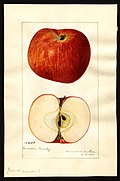 | Nottinghamshire, England | 1913 | A red mutation(sport) of Bramley. | Cooking | |
| Crimson Cox[87] |  | Herefordshire, England | Discovered 1913, Introduced 1928 | Mutation of Cox Orange Pippin. Skin covered with crimson. | Eating | |
| Crimson Crisp(a.k.a. Co-op 39)[88] |  | New Jersey, US | Cross made 1971 | A greenish-yellow apple with red-purple overcolor (95–100%). Flesh crisp, juicy, subacid. SS 13.5–16.5, TA 0.63, D 76. Stalk 12 mm (0.47 in). | Eating | Pick45 September 15. Pick55 September 5. Use October–December. |
| Crimson Delight | 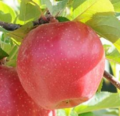 | Washington, United States | Crimson Delight is a multi-purpose apple intended for snacking, baking and fresh recipes. The fruit size is medium to large with a firm texture and is crisp and juicy. | Eating, baking | ||
| Crimson Gold[89] |  | Czech Republic | 1944 | A golf ball-sized applecrab hybrid developed by Albert Etter who named it Little Rosybloom for its cute size and attractive ruby red flush. He died before completing the patent papers. Fruit was later rediscovered and renamed. Very crispy and keeps texture in baking. | Eating, baking | Pick45 September 27. |
| Crimson Newton Wonder[6] |  | Holywell, Hertfordshire, England | 1921 | A more highly coloured sport of Newton Wonder. | Eating, Cooking | PickE mid-October. Use November - March |
| Crimson Pippin synonym of Detroit Red | ||||||
| Crimson Pippin synonym of Scarlet Pippin | ||||||
| Crimson Queening[7][13] |  | England | <1831 | A greenish-yellow apple flushed (50–75%) crimson. Width 73 mm (2.9 in), height 73 mm (2.9 in). Stalk variable. Cells roundish obovate, axile. Flesh greenish white, soft, sweet, juicy, subacid. | Cooking | PickE early September; use September–October |
| Crimson Superb[86] |  | Yorkshire, England | <1950 | Sport of Laxton's Superb | Eating | PickE early October |
| Crimson Topaz see Topaz | ||||||
| Cripps Pink ('Pink Lady')[90][67][43] | Australia | 1973, selected 1979, introduced 1989 | Flesh firm, crisp, very sweet and slightly tart. Light red, pink and light yellow-green striped skin. Width 70–75 mm (2.8–3.0 in). Weight 197 g (6.9 oz). SS 12.5–16.0, TA 0.71–0.91 | Cooking, eating | Pick45 October 21. Pick55 October 10. | |
| Cripps Red | Australia | 1973 | ||||
| Crispin (see Mutsu) | ||||||
| Criterion | New York | 1898 | One of parents believed to be Ben Davis, but very tart unlike parent. Dark red skin underlain with stripes. | Cooking, eating | ||
| Croncels (cs. Croncelské, fr. Transparente de Croncels, pl. Kronselska, ru. Prozracinoe Kronseliskoe)[4][33][16][91][17][8] |  | Crocels, France | Introduced 1869 | Round oblong. Pale milky yellow with occasional slight flush. Flesh pale yellow, tender, very juicy, subacid. Width 80–85 mm (3.1–3.3 in), height 67–73 mm (2.6–2.9 in). Weight 195 g (6.9 oz). Stalk 17 mm (0.67 in). Cold storage 4oC 60 days. VitC 26. Density 0.72 | Eating | PickG late August–mid-September. Use September–October |
| Cullasaga[10] |  | North Carolina, US | <1858 | Flesh yellow, tender, juicy, sweet flavor. | Eating | Use January–April |
| Curl Tail[7][13] | England | <1872 | A yellow apple. Width 70 mm (2.8 in), height 62 mm (2.4 in). Stalk short. Cells obovate, abaxile. Flesh is white, soft, dry, subacid. | Cooking | PickE mid-September; use October–December. | |
| Cutler Grieve[6] |  | Edinburgh, Scotland | Introduced 1912 | Width 76 mm (3.0 in), height 64 mm (2.5 in). Stalk 16 mm (0.63 in). Flesh is white, firm, strawberry flavour. Tree is weak. | Eating | PickE mid-September. Use October–November. |
D
[edit]| Common name | Image | Origin | First developed | Comment | Use | Pick/Use period |
|---|---|---|---|---|---|---|
| Dakota Beauty[11] | South Dakota, US | Introduced 1944 | ||||
| Damasonrenette see Reinette de Mâcon | ||||||
| Daniel[10][9] |  | Indiana, US | <1850 | A delightful dessert apple. Flesh white, fine grained, tender, juicy, subacid, aromatic. | Eating | Use August - September |
| Danziger Kantapfel(cs. Hranàč gdanský, fr. Calville de Danzig, pl. Kantowka gdanska, ru. Danțigskoe rebristoe)[24][17] |  | Germany | <1760 | A yellow apple with red overcolour. Width 63–78 mm (2.5–3.1 in), height 58–63 mm (2.3–2.5 in) Weight 118 g. Flesh yellowish white, subacid, slightly aromatic. | Cooking, eating | Pick October; use October–December |
| D'Arcy Spice agm[92][31][13][14] |  | Tolleshunt D'Arcy, Essex, England | 1785 | A medium-sized apple with yellow-green skin, a red blush where exposed to the sun and covered with a spotty ochre russet. Cells rounish obovate, axile, open. White flesh is aromatic, firm and crisp with noticeable hints of anise and clove. Width 67 mm (2.6 in), height 58–61 mm (2.3–2.4 in). Stalk 12 mm (0.47 in). P Reinette Franche x ? | Eating | PickE late October; use December–April |
| Davey[11] | Massachusetts, US | Introduced 1950 | P McIntosh x unknown. Tree bears earlier and more regularly than Baldwin, resistant to scab. | Eating | ||
| Dayton(a.k.a. Co-op 21)[93][43] | Urbana, Illinois, US | Cross made 1967. Selected 1976, introduced 1988 | A roundish to oblate apple, with red overcolor (up to 90%). Flesh: fine grained, firm, cisp, very good, subacid, 13,3% soluble solids, 0.3% titrable acid. Width 74 mm (2.9 in), height 65 mm (2.6 in). Stalk 18–21 mm (0.71–0.83 in). P N.J. 123249 x PRI 1235–000. Maturity 4 weeks before Delicious. | Eating | Pick55 August 12. | |
| Dazzle[83] |  | Hastings, New Zealand | cross made 1997 | Width 69 mm. A yellow-green apple with 95% red to orange overcolor. Susceptible to scab and powdery mildew. | Eating | ripens midseason. |
| Deacon Jones[26][27] |  | Pennsylvania, US | <1890 | Large oblong-conic, ribbed. Yellow with red flush. Tree vigorous. Flesh yellow, firm, coarse, crisp, tender, juicy, mild subacid, aromatic, fair to good. | Eating | Use November–March |
| Dean's Codlin[28][13] |  | Possibly England | <1844 | A large apple. Width 91 mm (3.6 in), height 74 mm (2.9 in). Stalk 15 mm (0.59 in). Cells elliptical, abaxile, wide open. Flesh yellowish, tender. | Cooking | Use December–March |
| De Jaune (see Jaune) | ||||||
| Delawine[11] | Ohio, US | Introduced 1948 | P Delicious x Stayman Winesap. Flesh juicy and flavor of Stayman Winesap. Tree strong grower. | |||
| Delblush[6] |  | France | 1979 | Tentation delblush, Golden Delicious × Grifer | Eating | |
| Delcon[11] | Missouri, US | Introduced 1948. | P Conrad x Deliciious. Tree dwarf tendency, heavy producer. | Eating | ||
| Delcorf (a.k.a. Delbarestivale)[94][8] | 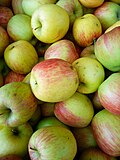 | France | 1960 | Parentage Golden Delicious × Stark Jonagrimes. Cold storage 3oC 50 days. | Eating | PickE early September. Use September–October. |
| Delfloga | France | 2008 | Delbardivine delfloga, Royal Gala Tenroy × Florina, scab resistant | Eating | ||
| Delflopion | Delbard, France | Sampion × Florina, scab resistant | Eating | |||
| Delgollune(a.k.a. Delbard Jubilée)[6] |  | France | 1960s | Width 75 mm, height 70–80 mm. Stalk 20 mm. Parentage Golden Delicious x Lundbytorp. Flesh white, crisp, juicy, aromatic, subacid. | Eating, Cooking | PickE mid to late October. Use November - February. |
| Delrouval |  | France | 1995 | Cybèle delrouval, Delcorf × Akane | Eating | |
| Deltana | France | 2010 | Delbard Celeste deltana, (Golden Delicious × Grive Rouge) × Florina, scab resistant | Eating | ||
| Democrat 1.(a.k.a. Varick)[9][27] |  | New York, US | <1869 | A yellow apple striped and splashed with red. Width 77 mm (3.0 in), height 70 mm (2.8 in). Stalk slender,24 mm (0.94 in). Flesh juicy, subacid, very good. Tree is good grower and a great bearer. | Eating | Use December–March |
| Democrat 2.[8] | Tasmania, Australia | c. 1900 | Width 57 mm, height 45 mm. Dark red flush. Flesh: crisp, sweet, juicy. Cold storage 0oC 150 days. | PickE late October. Use January–March. | ||
| Detroit Red (a.k.a. Detroit)[9][27] |  | Possibly the US | <1820 | Flesh, white, crisp, juicy, subacid. Width 84 mm (3.3 in), height 68 mm (2.7 in). Stalk 10 mm (0.39 in). Good. | Eating | Use October–February |
| Deutsher Goldpepping (a.k.a. Pomme d'Or d'Allemange)[28] |  | Germany | <1833 | A yellow apple. Width 59 mm (2.3 in), height 47 mm (1.9 in). Stalk 14 mm (0.55 in). | Eating, cooking | Use January–April |
| Devonshire Quarreden[7][31][58] | England, possibly France | 1685 (documented) | Possible French parentage or ancestry. Crimson red peel. Juicy. Width 51–64 mm (2.0–2.5 in), height 38–48 mm (1.5–1.9 in). Stalk 15 mm (0.59 in). Cells ovate, axile, split. Flesh greenish-white, crisp, juicy, sweet. Tree heavy cropper on warm soil. | Eating | PickE mid–late August; use late August–early September | |
| Dewdney's Seedling[7] |  | Lincolnshire, England | c. 1850 | Large, irregular, late cooking apple. Flesh juicy, acid. Width 95 mm (3.7 in), height 80 mm (3.1 in). Stalk very short. | Cooking | PickE late August–early September; use October–January |
| Diamond Jubilee[14] | Kent, England | <1901 | A yellow apple. AM from RHS in 1901. Flesh firm, white, good. | Eating, cooking | PickE mid-October. Use January–March | |
| Dietzer Gold-Reinette(a.k.a. Reinette de Dietz)[28][34] |  | Germany | <1820 | Width 56–67 mm, height 50–54 mm. Stalk 12 mm. Flesh juicy, aromatic, subacid. | Eating, cooking | Use January - April. |
| Dijkmanszoet[16] | A yellow to green apple with red stripes. Width 75 mm (3.0 in), height 64 mm (2.5 in). Stalk 18 mm (0.71 in). | Cooking | Use November–April | |||
| Discovery agm[95][31][4][8] |  | Essex, England | 1949. Introduced 1949. | P Worcester × Beauty of Bath. Width 66 mm (2.6 in), height 48 mm (1.9 in). Stalk 10 mm (0.39 in). Sharp, sweet flavour. Fruits are sold commercially in the United Kingdom. Cold storage 4oC 30 days. | Eating | PickE mid–late August. PickG mid-August. Pickg August 15–30. Use mid-August–mid-September |
| Diwa (see Junami) | ||||||
| Doctor[9][27] |  | Pennsylvania, US | <1817 | Flesh tender, juicy, aromatic, subacid. Good. | Eating | Use October–January |
| Doctor Hogg[13] |  | England | <1878 | A golden yellow apple striped with crimson. Width 83 mm, height 74 mm. Cells obovate, abaxile. Flesh white, tender, juicy. FCC from RHS in 1878. | Cooking (Eating) | Pick early September. Use November - February. |
| Domine[27] | 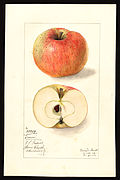 | US | <1831 | Width 74 mm (2.9 in), height 56 mm (2.2 in). Stalk 29 mm (1.1 in). Flesh exceedingly tender and juicy. | Eating | Use December–April |
| Domino[14][13] | Possibly Nottinghamshire, England | <1883 | Oblong, rounded, irregular. Pale yellowish green. Width 64 mm (2.5 in), height 70 mm (2.8 in). Stalk short. Cells elliptical, abaxile. Flesh crisp, acid. | Cooking | PickE mid August. Use August–September. | |
| Domnesc (a.k.a. Pomme de Moldavie, Herrenapfel, ru. Domneşti)[19][17] |  | Moldova | <1800 | Width 100 mm (3.9 in), height 70–80 mm (2.8–3.1 in), weight 170–210 mm (6.7–8.3 in). Flesh, juicy, sweet sour. | Eating | PickG September. PickE mid-October. Use October–January. |
| Dorsett Golden[18] |  | Bahamas | 1964 | Grown from chance seedling of Golden Delicious. Yellow with red flush (10–40%). Flesh sweet, subacid, good. Tree vigorous. One of the most southerly apples grown in North America. | Eating | PickE mid-October. Use December–January. |
| Double Red Baldwin[11] | New Hampshire | Discovered 1924. Introduced 1927. | Mutation of Baldwin. Darker red than Baldwin | Eating | ||
| Double Red Delicious (see Starking) | ||||||
| Double Red Duchess (see Red Duchess) | ||||||
| Double Red McIntosh (see McIntosh Rogers) | ||||||
| Double Red Rome Beauty[11] | Washington, US | Discovered 1925, Introduced 1927 | Mutation of Rome Beauty. | Eating | ||
| Double Red Wealthy[11] | New York, US | Discovered 1933, Introduced 1940 | Dark red mutation of Wealthy. | Eating | ||
| Double Red Willow Twig[11] | Illinois, US | Discovered 1927, Introduced 1929. | Dark red mutation of Willow Twig | Eating | ||
| Dougherty/Red Dougherty |  | Australia, New Zealand | 1930 | Red Dougherty is a recent mutation discovered in New Zealand from the old Australian Dougherty. | Eating | |
| Doux d'Argent[33][34] | Anjou, France | <1839 | A yellow to green apple. Width 78–92 mm (3.1–3.6 in), height 58–72 mm (2.3–2.8 in). Stalk 5–10 mm (0.20–0.39 in). | Use December–January. | ||
| Downton Pippin(a.k.a. Elton Pippin, Downton Golden Pippin, Elton Golden Pippin, Knights's Golden Pippin)[12][13][58] |  | Herefordshire, England | 1806 | A dessert apple of first-rate quality. Width 54 mm (2.1 in), height 44 mm (1.7 in). Cells obovate, axile, slit. Parentage: Orange Pippin x Golden Pippin. Flesh yellowish white, firm, crisp, juicy, aromatic. | Eating | PickE mid-September. Use November–January |
| Drakenstein[18] | South Africa | Introduced 1981 | Round, bright red. P (Wemmershoek x Granny Smith) x Richared Delicious. Tree vigorous. | Eating | ||
| Dr. Seelig's Oranje Reinette[16] | Kiel, Germany | A yellow to green apple with no overcolor. Width 73 mm (2.9 in), height 62 mm (2.4 in). Stalk 18 mm (0.71 in). | Use November–January | |||
| Dubbele Bellefleur[39] |  | ? | <1760 | A green apple striped with red. Width 74–79 mm, height 55–60 mm. Stalk short. | Pick October. Use October–November. | |
| Duchess of Bedford[6] |  | Bedford, England | <1918 | Parentage Cellini x Beauty of Bath. Width 66 mm, height 54 mm. Flesh white, soft, aniseed flavour. | Eating | PickE mid August. Use August–September. |
| Duchess of Oldenburg (a.k.a. cs. Charlamowski, de. Charlamowsky, fr Borowinka, Borowitsky, Borowicki, pl. Charlamowska)[7][24][33][16][13][26][28][17] |  | Russia | <1824 | Has red stripes with splashes of green. Excellent resistance to freezing temperatures. Stalk 8–20 mm (0.31–0.79 in). Width 69–89 mm (2.7–3.5 in), height 57–73 mm (2.2–2.9 in). Weight 144 gram. Cells ovate, axile. | Cooking, eating | Pick45 August 14. Pick55 July 25. Use September–March |
| Duchess's Favourite[31][13] |  | Surrey, England | c. 1800 | A yellow apple with red flush. Width 58 mm (2.3 in), height 61 mm (2.4 in). Stalk 12 mm (0.47 in). Cells roundish obovate, axile, open. Flesh yellowish white, tender, juicy, subacid. Tree rather slow in bearing, but then a heavy cropper. | Eating | Pick late August; use August–September |
| Dudley Winter (a.k.a. Dudley)[27] |  | Castle Hill, Maine, US | 19th century | A medium-sized oblate apple with greenish-yellow skin covered with red stripes over a solid red blush. Width 74 mm (2.9 in), height 60 mm (2.4 in). Stalk 12 mm (0.47 in). Flesh is firm but tender, juicy, aromatic and quite tart, becoming milder as it ages. Good for fresh eating and cooking; rated by many as one of the best for apple pies and sauces. Tree is a natural semi-dwarf, very hardy and bears heavily annually. | Cooking, eating | |
| Dukat[8] |  | Czechoslovakia | 1965 | Width 73–80 mm, height 60–68 mm. Stalk 25 mm. Parentage Golden Delicious x Cox Orange. Cold storage 3oC 60 days. | ||
| Duke of Devonshire[7][31][28] |  | Lancashire, England | Raised 1835. Introduced 1875 | Dessert apple, resistant to scab and canker. Width 61–69 mm (2.4–2.7 in), height 54–56 mm (2.1–2.2 in). Stalk 5 mm (0.20 in). | Eating | PickE early October; use January–March |
| Dülmener(aka Dülmener Rosenapfel, Dülmener Herbstrosenapfel)[4][96][8] | 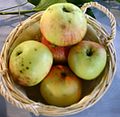 | Germany | 1870 | Width 83 mm (3.3 in), height 68 mm (2.7 in), weight 195 mm (7.7 in). Stalk 10–16 mm (0.39–0.63 in).Cold storage 3oC 90 days. VitC 6. Density 0.81 | Cooking, eating | PickE mid-September. PickG mid–late September; use September–December |
| Dummellor's Seedling(a.k.a. Dumelow's Seedling) agm[97][98][31][13] |  | Shackerstone, Leicestershire, England | <1800 | Roundish-oblate apple with pale greenish-yellow skin strewn with large russet dots, occasionally covered with a delicate pinkish-orange blush. Width 77 mm (3.0 in), height 61 mm (2.4 in). Stalk 11–14 mm (0.43–0.55 in). Cells obovate, axile to abaxile. Flesh yellow-tinted white flesh, aromatic, firm, crisp, tart, and very juicy. One of the most widely grown culinary apples of Victorian England, esteemed for its fine flavour and good keeping qualities. | Cooking | PickE mid-October; use November–March |
| Dungay[13] | England | <1884 | An excellent cooking apple. Width 76 mm (3.0 in), height 63 mm (2.5 in). Stalk 25 mm (0.98 in). | Cooking | Use October–December | |
| Dunning[11] | Geneva, New York, US | Raised 1923. Introduced 1938 | P Early McIntosh x Cox Orange. Flesh sweet. | Eating | Pick early August. PickE late August. Use August–September. | |
| Dutch Codlin (a.k.a. Chalmers Large, Glory of the West)[13][58] |  | Possibly the Netherlands | 1783 | One of the best kitchen apples. Greenish yellow with red flush. Stalk 25 mm (0.98 in) and thick. Eye small and closed. Flesh white and sub-acid. | Cooking | PickE early September. Use September. |
| Dutch Mignonne[99][32][33][35] |  | Holland or Germany | <1766 | Medium size round. Width 60–80 mm (2.4–3.1 in), height 55–70 mm (2.2–2.8 in). Cells obovate, axile, open. Flesh, cream, crisp, juicy. Stem long. | Eating, cooking, baking, drying, juice | PickE early October. Use November–April. |
| Dyer (a.k.a. Pomme Royale)[26][9][27] |  | A yellow apple with brown flush. Width 72 mm (2.8 in), height 60 mm (2.4 in). Stalk 20 mm (0.79 in). Tree vigorous. Flesh yellow, crisp, tender, aromatic, subacid, aromatic, very good to best. | Eating | PickE early September. Use September–October. | ||
| Dymock Red[13] | Gloucestershire, England | A roundish or oblate red apple. Width 54 mm (2.1 in), height 41 mm (1.6 in). Stalk very short. Cells ovate, axile, closed. Flesh yellowish, soft, tender, subacid. | Eating, cider | Pick late September |
E
[edit]| Common name | Image | Origin | First developed | Comment | Use | Pick/Use period |
|---|---|---|---|---|---|---|
| Egle | Lithuania | Eating | ||||
| Eady's Magnum[7] | England | c. 1908 | Width 91 mm (3.6 in), height 73 mm (2.9 in). Stalk short. Flesh white, juicy, acid. | Cooking | PickE mid-October; use December–March | |
| Early Blaze[8] | US | Introduced 1957 | Cold storage 2oC 60 days | |||
| Early Bough see Sweet Bough | ||||||
| Early Chandler[9] |  | US | <1875 | Stalk short. Flesh yellow, tender, juicy, subacid. Too acid for eating. | Cooking | Use August |
| Early Cortland[100] | Geneva, New York, US | Cross made 1938, selected 1949 | Diameter 75–90 mm (3.0–3.5 in). Skin color 60–95% red. P Cortland x Lodi. | Eating | ||
| Early Harvest (a.k.a. July Pippin, Yellow Harvest, Tart Bough)[9][10][27][26][13][58] |  | US | <1806 | Width 58–85 mm (2.3–3.3 in), height 39–70 mm (1.5–2.8 in). Stalk 17–20 mm (0.67–0.79 in). Cells obovate axile, open. Flesh white, crisp, tender, juicy, subacid, good to very good. | Eating | Pick July; use July |
| Early Joe[9][10][26][27] |  | New York US | <1843 | Width 61 mm (2.4 in), height 46 mm (1.8 in). Stalk 20 mm (0.79 in). Flesh whitish, tender, juicy, vinous flavor, very good to best. Tree is a slow grower. | Eating | Use mid-August–mid-September |
| Early Julien (a.k.a. Early Julyan)[12][13] |  | Scotland | <1800 | An excellent culinary apple. The tree is not a large grower. Width 60 mm (2.4 in), height 48 mm (1.9 in). Cells ovate, round or oblate, open or closed. Flesh yellowish, white, crisp, very juicy. | Cooking | PickE August, use August |
| Early McIntosh[11] |  | Geneva, New York, US | Introduced 1923 | P Yellow Transparent x McIntosh. Flavor excellent. | Eating | Pick early August |
| Early Nonpareil[13] | Norfolk, England | c. 1780 | Width 57 mm (2.2 in), height 45 mm (1.8 in). Cells obovate, axile. Flesh crisp, aromatic, subacid. | Eating | Use October - December. | |
| Early Pennock (a.k.a. Shaker Yellow, Homony)[10] |  | US | <1800 | Width 79 mm (3.1 in), height 70 mm (2.8 in). Stalk 12 mm (0.47 in). Flesh yellow, avid. Quality poor. | Cooking | Use July–August |
| Early Red Bird see Crimson Beauty | ||||||
| Early Red Juneating see Margaret | ||||||
| Early Ripe[9][27] | 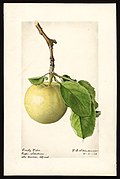 | Possibly Pennsylvania, US | <1867 | Width 75 mm (3.0 in), height 59 mm (2.3 in). Stalk 15 mm (0.59 in). Flesh white, tender, juicy, subacid. Good. Tree productive. | Eating | |
| Early Strawberry[9][10][27][26] | 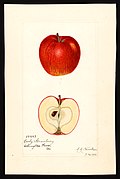 | New York, US | <1838 | Width 58–63 mm (2.3–2.5 in), height 49–52 mm (1.9–2.0 in). Stalk 25–33 mm (0.98–1.30 in). Flesh white, tender, subacid, aromatic, very good. | Eating | Use July–September |
| Early Victoria (a.k.a. Emneth Early)[7][16][8] | Essex, England | 1899 (introduced) | Pale yellow fruit. Possibly from Lord Grosvenor × Keswick Codlin. Width 71 mm (2.8 in), height 67 mm (2.6 in). Stalk 18 mm (0.71 in). Flesh; greenish-white, crisp, firm, acid. Cooks well, breaks up completely when cooked. Cold storage 1oC 60 days. | Cooking, eating | PickE late July–early August. Use August–September. | |
| Easter Orange[53][14] | England | <1897 | Round conical, deep golden yellow with flush and stripes of dark brown red. Flesh firm, yellow, of good flavour. AM from RHS in 1897. Width 66 mm (2.6 in), height 63 mm (2.5 in). | Eating | PickE early October. Use February–April | |
| Ecklinville[7][13] |  | Ecklinville, Ireland | c. 1820 | Large, round, greenish-yellow. Width 78–87 mm (3.1–3.4 in), height 63–70 mm (2.5–2.8 in). Stalk short. Cells ovate, abaxile. An excellent early cooker. Flesh; white, soft, fine-textured, acid, juicy. | Cooking | PickE early September; use September–October |
| Ecolette[21] |  | Wageningen, Netherlands | Flesh: firm, juicy, shap, aromatic. Parentage Elstar x Prima. | Eating | PickE October | |
| Edelborsdorfer (cs. Mišenské, Mišeň česká, ru. Borsdorfskoe blagorodnoe)[80][17] |  | Germany | <1600 | A green apple with red flush and russet. Width 70 mm (2.8 in), height 63 mm (2.5 in). | Eating, cooking | PickE mid-October; use December–March |
| Edelrother[28] |  | <1856 | Yellow with red flush. Width 65 mm (2.6 in), height 61 mm (2.4 in). Stalk 16 mm (0.63 in). | Eating | Use November–January | |
| Edith Hopwood[30] |  | Essex, England | <1929 | Yellow with russet. Stalk very long. | Eating | PickE early September. Use October–November |
| Edward VII[14]agm[101][31] |  | Worcestershire, England | 1908 (introduced) | A large oblate-round apple with yellow-green skin and pinkish-brown blush. Width 76–83 mm (3.0–3.3 in), height 60–70 mm (2.4–2.8 in). Stalk 6 mm (0.24 in). AM from RHS in 1903. Suitable for more northerly, cold, wet climates. Flesh; pale yellow, firm, coarse-textured, juicy, acid. Extraordinary keeper; apple ripens in autumn and will keep until Easter. P Possibly Blenheim Orange × Golden Noble. Cooks well, breaks up completely. | Cooking | PickE mid-October; use December–April |
| Edwards[9] |  | North Carolina, US | <1869 | A greenish yellow apple, lightly striped with red. Flesh juicy, firm. One of the best keepers. | Eating | PickE mid-October. |
| Edwin Beckett[30][102] | England | <1915 | Green to yellow with red flush. Width 100 mm (3.9 in), height 114 mm (4.5 in). | Cooking | ||
| Egremont Russet agm[103][31][30] |  | Sussex, England | <1872 | Width 64–68 mm (2.5–2.7 in), height 48–57 mm (1.9–2.2 in). Stalk 6–10 mm (0.24–0.39 in). Brown russeting. Excellent keeper. Resistant to scab, very prone to bitter pit. Flesh; cream, firm, fine-textured, dry, nutty flavor. | Eating | PickE late September; use October–December |
| Eifeler Rambur[32] |  | A yellow apple striped with red. Width 65–85 mm (2.6–3.3 in), height 50–65 mm (2.0–2.6 in). Flesh crisp, dry, subacid. C 8. | Eating, cooking, baking | Use December–March | ||
| Ein Shemer[18] | Israel | 1963 | P Zabidani × Golden Delicious. Tastes tart, does not do well in cold weather. (Not the same as Anna (apple)) | Eating | Ripens in June | |
| Elektra[4] |  | Germany | Width 68 mm (2.7 in), height 58 mm (2.3 in), weight 95–100 g (3.4–3.5 oz). Stalk 5–15 mm (0.20–0.59 in). | Cooking, eating | PickE early October. PickG mid–late October; use November–February | |
| Elise Rathke[28] |  | Danzig | <1880 | A yellow to green apple, with red overcolor. Width 60 mm, height 52 mm. Stalk 9 mm. Flesh yellowish-white, juicy, subacid, aromatic. | Eating | Pick October. Use December–April. |
| Ellison's Orange[30][14] agm[104][31][78][16][8] |  | Bracebridge, Lincolnshire, England | Introduced 1911 | Width 67–75 mm (2.6–3.0 in), height 57–61 mm (2.2–2.4 in). Stalk 12–35 mm (0.47–1.38 in). P Cox's Orange Pippin × Cellini. AM from RHS in 1911. FCC from RHS in 1917. Rich aniseed flavor. Flesh; creamy white, soft, juicy, subacid, aniseed flavour. Cold storage 4oC 120 days. | Eating | PickE mid-September; use September–October. |
| Elstar agm[105][43][8] |  | Netherlands | Cross made 1955 | Golden Delicious × Ingrid Marie. Flesh white, firm, good flavor, acid at harvest. Medium-sized, mostly red with yellow showing. Often used in desserts due to its intense honey flavor. Susceptible to powdery mildew and Phytophthora rot. Cold storage 2-3oC 90 days. | Cooking, eating | PickE early October. Pickg September 23–October 7. Use October–December. |
| Emneth Early[106][14] agm[107][31] |  | Cambridgeshire, England | <1899 | Width 64 mm (2.5 in), height 61 mm (2.4 in). Stalk 23 mm (0.91 in). Suitable for northerly, cold, wet climates. P Hawthornden x Keswick Codlin. A biennial crop that needs thinning. AM from RHS in 1899. Good disease resistance. | Cooking | PickE late July–early August; use July–August |
| Empire[108][4][8] |  | Geneva, New York, US | Introduced 1966 | P McIntosh x Red Delicious.Flesh; white, juicy, subacid. Tangy taste. Ruby red color. Cold storage 2oC 120 days. | Eating | Pick45 September 25. Pick55 September 10. PickG mid-September. Use October–December. |
| Empire Red[11] | British Columbia, Canada | Introduced 1942 | A red apple. P unknown. | Cooking, eating | ||
| Empress[18][43] | Geneva, New York, US | Cross made 1969, selected 1977. Introduced 1988 | A dark red apple, fair. Width 60–65 mm. P Jonamac x Vista Bella. Flesh light yellow, semifirm, subacid. | Eating, cooking | ||
| Encore[7][31][14] |  | Berkshire, England | 1906 | Large cooking apple. Width 83–96 mm (3.3–3.8 in), height 73–90 mm (2.9–3.5 in). Stalk 10–15 mm (0.39–0.59 in). First Class Certificate from RHS in 1908. Flesh; creamy white, soft, coarse-textured, juicy, subacid. Excellent cooker. | Cooking | PickE early–mid-October; use December–April |
| Engelsberger[5][4] |  | Germany | 1854 | A German cider apple. Sugar-acid ratio 10:1. Juice yield 70–75%. Flesh; white, juicy, acid. | Cider, juice | PickG late September. Use late September–early October |
| English Codlin (a.k.a. Common Codlin, Codlin, Quodlin)[14][13] | England | <1600 | Yellow with red flush and russet. Width 82 mm (3.2 in), height 64 mm (2.5 in). Cells obovate, abaxile. Flesh, tender, white. acid, good. Stalk long. | Cooking | Use August–September | |
| English Russet[9][10] |  | <1870 | Width 69 mm (2.7 in), height 62 mm (2.4 in). Stalk 13 mm (0.51 in). Flesh yellowish-white, crisp, subacid. Good. | Eating | Use January–May | |
| Enterprise(a.k.a. Co-op 30)[109][110][44] | Illinois, US | Selected 1978, introduced 1993 | A yellow apple with red overcolor (95%). Width 89 mm (3.5 in), height 76 mm. Overcolor 88%. Stalk short. Flesh firm, crisp, spicy. Stores well up to six months. Makes very good candy apple. | Eating | Pick50 October 20–30. Pick55 October 8–20. | |
| Envy |  | New Zealand | 2009 | Sweet and crispy, takes 4–8 hours after cutting to start browning. Royal Gala × Braeburn. | Eating | |
| Epicure[7] | Bedford, England | 1909 | Yellowish apple with reddish blush. Good clean taste. Award of Merit from RHS in 1931. Width 63 mm (2.5 in), height 54 mm (2.1 in). Stalk long. Needs thinning for size. Prone to bitter pit, canker. | Eating | PickE mid–late August; use August–September. | |
| Erickson[11] | Minnesota, US | Introduced 1923 | A large green apple. | |||
| Eris[111] | Greece | Introduced 2016 | A red apple. Width 71 mm (2.8 in), height 73 mm (2.9 in). Stalk 12 mm (0.47 in). Weight 222 g (7.8 oz). Flesh: white-yellowish, juicy, crisp, aromatic. P Black Ben Davis x Red Chief. SS 14.1% TA 0.3%. C 8. DBH 143. | Eating | Pick September 7–13. Use September–April. | |
| Erwin Baur[4][32][8] |  | Germany | 1928, introduced 1955 | Width 68–80 mm (2.7–3.1 in), height 57 mm (2.2 in), weight 105–212 g (3.7–7.5 oz). Stalk 15–20 mm (0.59–0.79 in). Cold storage 1oC 120 days. Vit C 7. Density 0.85 | Cooking, eating | PickE early October. PickG early–mid-October; use December–March |
| Esopus Spitzenburg[9][27][26][13][28] |  | Esopus, New York, US | c. 1750 | Grown by Thomas Jefferson at Monticello. Named for creek near which first seedling found. Heirloom variety still available at farmstands in Northeast and portions of Virginia. Flesh yellow, firm, crisp, juicy, aromatic, subacid, very good to best. Difficult to grow for inexperienced planters. Width 73–77 mm (2.9–3.0 in), height 68–76 mm (2.7–3.0 in). Stalk 19–24 mm (0.75–0.94 in). Cells ovate, axile, slit. | Cooking, eating | PickE early–mid-October. Use December–February |
| Etter's Gold[11] | California, US | Introduced 1944 | Golden yellow. P unknown. Flesh crisp. | Pick October | ||
| Eva[18] | Brazil | A yellow apple red striped (70%). P Gala x Anna. Flesh sweet, subacid, good. Tree very productive. | Eating | |||
| Evagil[14] |  | England | Introduced 1863 | A golden yellow apple. Stalk very short. Flesh pale yellow, hard, dry. | Cooking, eating | PickE late August. Use September–October |
| Evening Party[9] |  | US | <1860 | Width 68 mm (2.7 in), height 52 mm (2.0 in). Stalk 14 mm (0.55 in). Flesh juicy, vinous, aromatic. | Eating | Use December–January |
| EverCrisp[112] | Indiana, US | 2008 | Described as Fuji x Honeycrisp | Eating | Pick45 October 10. Pick55 October 3. | |
| Ewalt[10] |  | Pennsylvania, US | <1850 | A large apple, yellow with red flush. Width 75 mm (3.0 in), height 63 mm (2.5 in). Flesh acid, aromatic. | Eating | Use February–April |
| Exeter Cross[7][76] |  | Long Ashton, England | 1924, introduced 1952 | P Worcester Pearmain x Beauty of Bath. Width 59 mm (2.3 in), height 47 mm (1.9 in). Stalk variable. Flesh crisp, juicy, sweet. | Eating | PickE early August; use August |
| Exquisite (Laxton Exquisite)[7] | Bedford, England | 1902 | Award of Merit from RHS in 1926. Width 70 mm (2.8 in), height 67 mm (2.6 in). Stalk short to medium. Flesh sweet, aromatic. P Cox Orange x Cellini. | Eating | PickE late August; use September–October |
F
[edit]| Common name | Image | Origin | First developed | Comment | Use | Pick/Use period |
|---|---|---|---|---|---|---|
| Fagerö[80][25] |  | Sweden | <1860 | Width 75–80 mm (3.0–3.1 in), height 68 mm (2.7 in). A red mutant of Grågylling. | Eating | Use October–December |
| Fallawater (a.k.a. Tulpehocken)[10][27][26] |  | Pennsylvania, US | <1842 | Width 88 mm (3.5 in), height 70 mm (2.8 in). Stalk 8 mm (0.31 in). Flesh greenish white, crisp, juicy, mild subacid, good. | Eating | Use November–December |
| Fall Harvey[27] |  | US | <1838 | Flesh whitish, crisp, juicy, subacid, high flavor. | Eating | PickE mid-September. Use October–December |
| Fall Jenneting (a.k.a. Fall Jeneting)[27] |  | Connecticut, US | <1827 | Flesh yellow, crisp, tender, juicy, subacid. The tree is a strong grower. | Cooking | Use September–December |
| Fall Orange[27][9] |  | Massachusetts, US | <1848 | Pale yellow. Width 85 mm (3.3 in), height 75 mm (3.0 in). Stalk 17 mm (0.67 in). Flesh white, crisp, tender, juicy, subacid, aromatic. A poor shipper. Biennial. Quality: eating excellent, cooking very good. | Eating, cooking | Use September–December |
| Fall Pippin[9][57][10][26][13][58] |  | US | <1806 | Large yellow, roundish to roundish oblate. Width 99 mm (3.9 in), height 86 mm (3.4 in). Stalk 22 mm (0.87 in). Cells obovate, axile. Flesh whitish - yellow, firm, fine, tender, very juicy, subacid, aromatic, very good. AS s. TRI | Eating, cooking | PickE mid-September; use September–December |
| Fall Russet[6] |  | US | c1875 | Flesh aromatic, good. | Eating | PickE early to mid September. Use September - October. |
| Fall Swaar (a.k.a. Autumn Swaar)[10] |  | US | <1800 | Width 70 mm (2.8 in), height 58 mm (2.3 in). Stalk 13 mm (0.51 in). Flesh yellow, juicy, mild subacid. | Cooking, eating | Use September |
| Fall Wine (a.k.a. Ohio Wine, Musk Spice, Sweet Wine)[9] |  | US | <1800 | Width 75 mm (3.0 in), height 56 mm (2.2 in). Stalk 23 mm (0.91 in). Flesh yellowish, juicy, aromatic, mild, subacid, sweet. | Eating | Use September–November |
| Falstaff[113][43] | Kent, England | 1966, introduced 1989. Red stripes on yellow-green background.|A good pollinator. Width 65–75 mm. Parentage James Grieve x Golden Delicious. | Dessert | PickE early October. Use October–December. | ||
| Fameuse[7][10][9][27][114][26] |  | Canada | <1730 | Small apple, very sweet, flavour similar to McIntosh. Flesh white, tender, juicy, subacid, perfumed, very good. Width 60–72 mm (2.4–2.8 in), height 53–56 mm (2.1–2.2 in). Stalk 11–17 mm (0.43–0.67 in). Of no value in Britain. | Eating | Pick45 September 26. PickE late September–early October. Use October–November. |
| Family[9] |  | Georgia, US | <1860 | Width 78 mm (3.1 in), height 58 mm (2.3 in). Stalk 20 mm (0.79 in). Flesh White, juicy, mild, pleasant, subacid. | Eating | Use August–September |
| Fanny[57][26][27] |  | Pennsylvania, US | <1869 | A bright red fruit of good dessert quality. Width 63 mm (2.5 in), height 50 mm (2.0 in). Roundish slightly oblate. Tree vigorous. Flesh yellow, firm, fine, tender, juicy, mild subacid, good to very good. | Eating | Use September–November |
| Faurot[11] |  | Missouri, US | Introduced 1935 | P Ben Davis x Jonathan. The tree is disease resistant. | ||
| Fearns Pippin[12][13][34] | London, England | <1780 | An excellent apple for eating and cooking. The tree is very hardy and a great bearer. Width 64 mm (2.5 in), height 53 mm (2.1 in). Stalk medium. Cells obovate, axile, slit. | Cooking, eating | PickE late September–early October; use November–February | |
| Federal Pearmain (a.k.a. Staaten Parmäne)[13][34] | England | <1831 | Width 70 mm (2.8 in), height 57 mm (2.2 in).Stalk 13 mm. Cells oblate, axile. Yellow red streaked. Flesh vinous. | Eating | Use December - March. | |
| Feltham Beauty[14] |  | Buckinghamshire, England | <1908 | Yellowish-green with red stripes and flush. Width 76 mm (3.0 in), height 70 mm (2.8 in). P Cox Orange x Gladstone. Flesh, crisp, sweet, very good. | Eating | PickE early August. Use August–September |
| Fenouillet Gris[12][33][34] |  | France | 1608 | A dessert apple of great excellence. Width 64 mm (2.5 in), height 50 mm (2.0 in). Short stalk. | Eating | PickE mid-October; use November–February |
| Feuillemorte[6] |  | France | <1948 | Flesh crisp, brisk, juicy. | Eating, juice | PickE late October. Use December - March. |
| Fiesta agm[115][31][43][8] |  | Kent, England | Cross made 1971, selected 1979. | Sometimes called Red Pippin. Claims both UK and US heritage: P Cox's Orange x Idared. Width 58 mm (2.3 in), height 51 mm (2.0 in). Stalk 22–30 mm (0.87–1.18 in). Has flavour similar to the former but storage, colouring, and cold tolerance of the latter. Can be susceptible to scab and canker. Cold storage 2oC 90 days. | Eating | PickE mid–late September; use October–January |
| Filippa[25][8] |  | Denmark | 1893 | A yellow apple with some red overcolour. Width 63 mm (2.5 in), height 58 mm (2.3 in). Cold storage 1oC 150 days. | Cooking, eating | PickE mid-September; use September–December |
| Fillbasket[12] | England | <1875 | Name of two different apple cultivars. One from Lancashire and the other from Kent. | Cooking | ||
| Fink (a.k.a. Fink's Seedling)[10] |  | Ohio, US | <1847 | A small apple. Flesh whitish, juicy, subacid good to very good. Good keeping qualities (one year). | Eating | |
| Finkenwerder Prinz (a.k.a. Finkenwerder Herbstprinz)[32][4][8] |